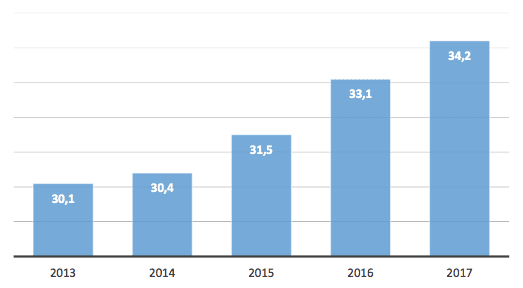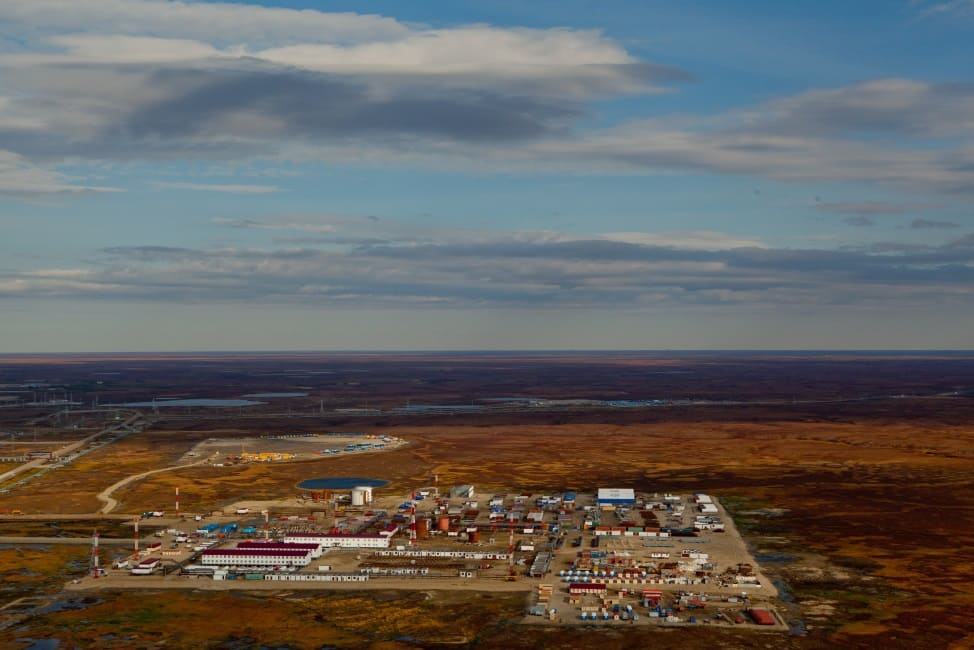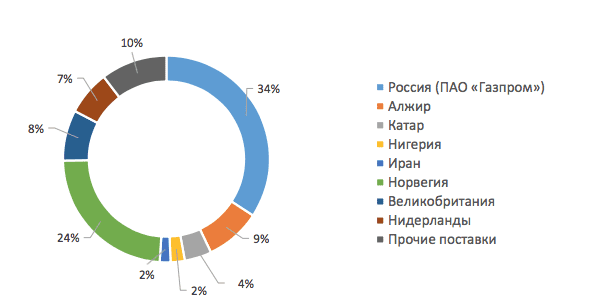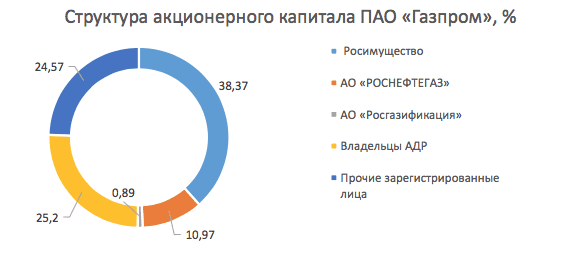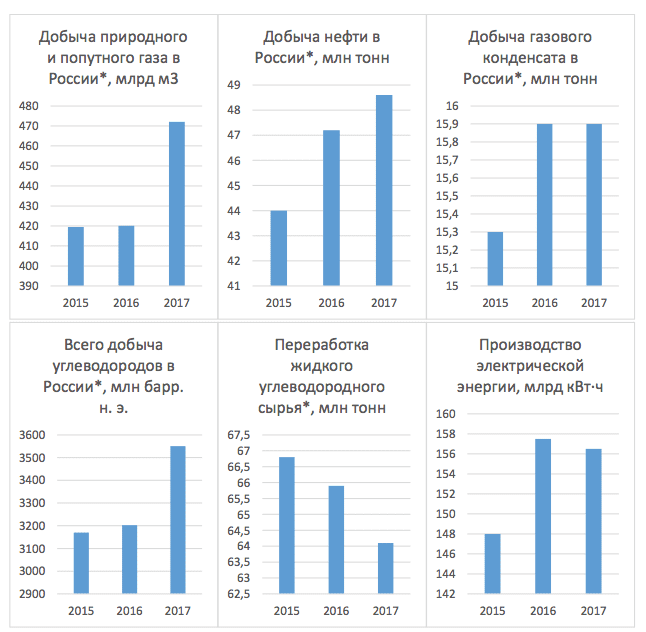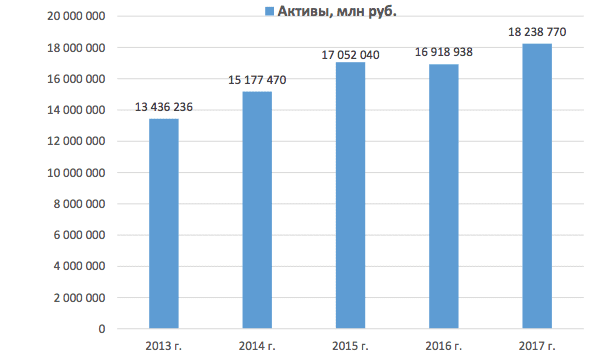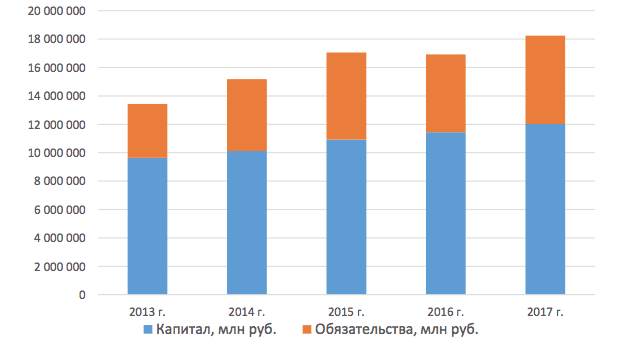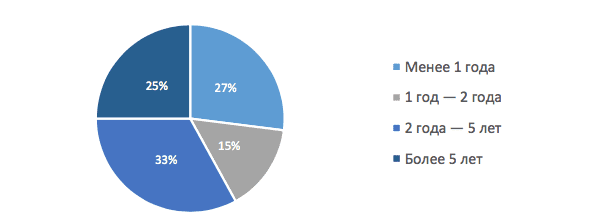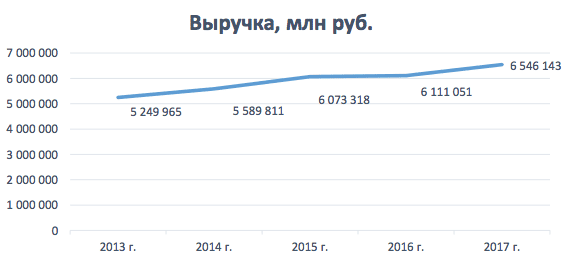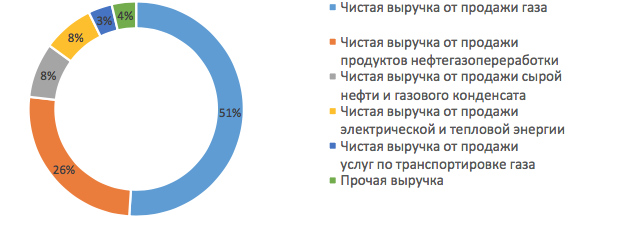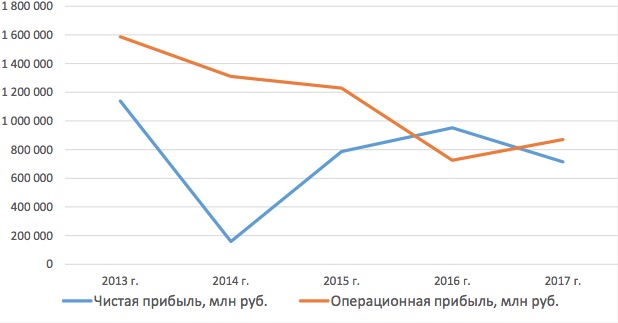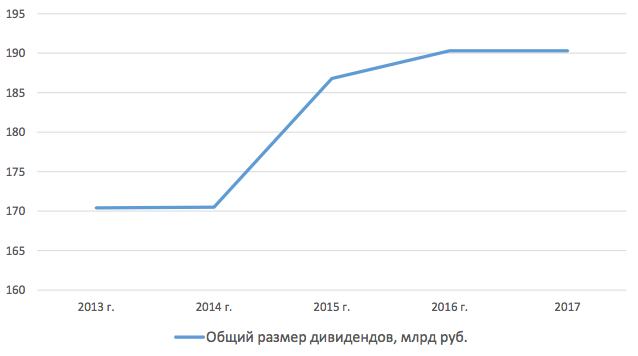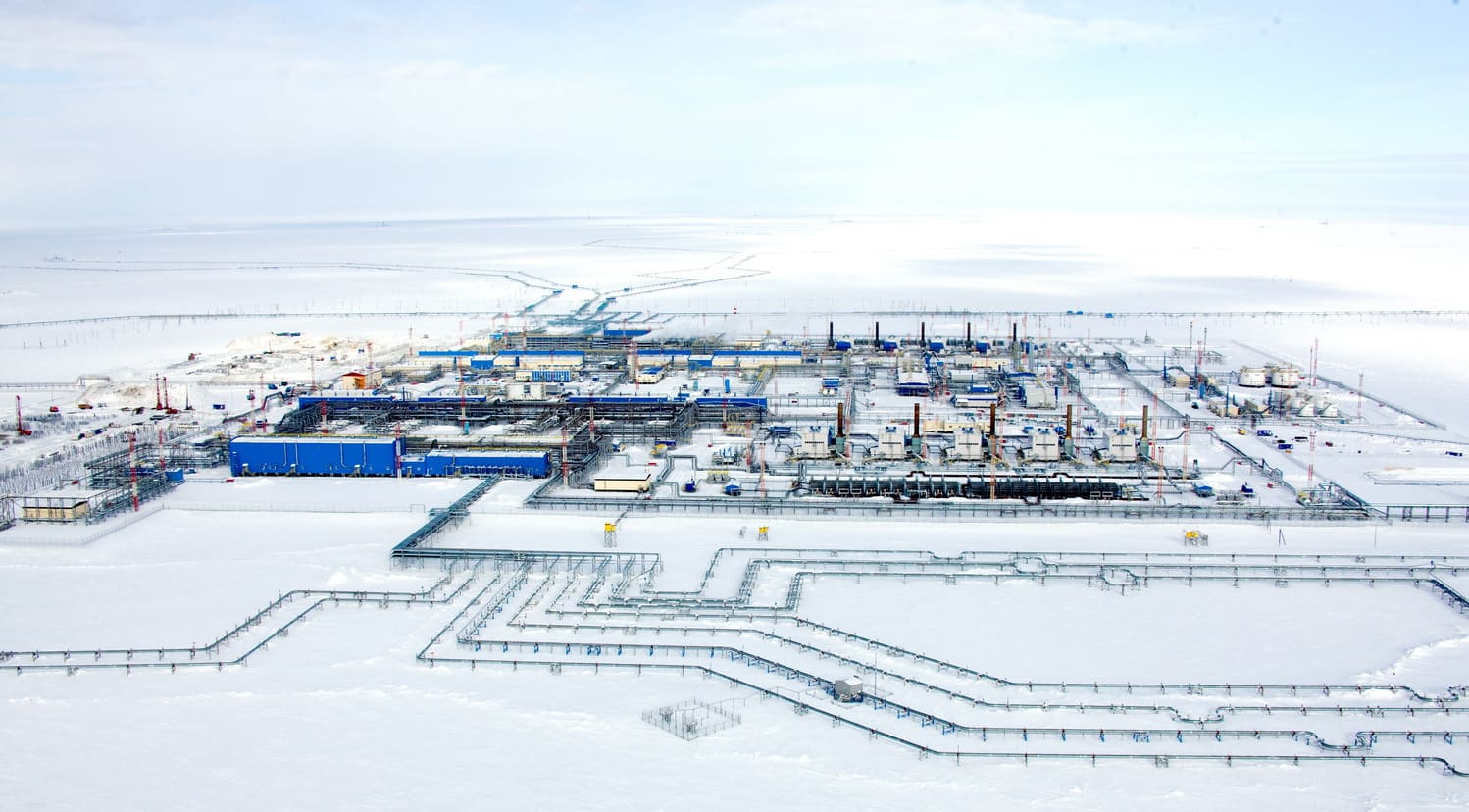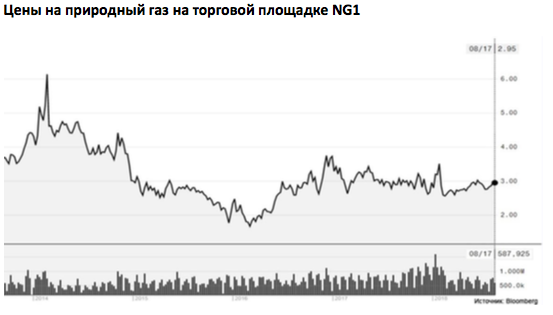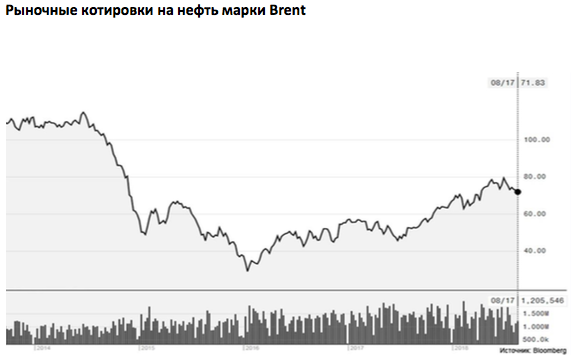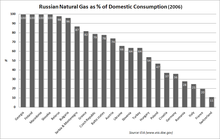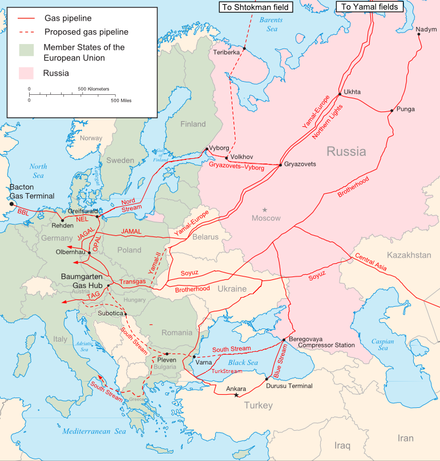ПАО «Газпром» — глобальная энергетическая компания. Основные направления деятельности — геологоразведка, добыча, транспортировка, хранение, переработка и реализация газа, газового конденсата и нефти, реализация газа в качестве моторного топлива, а также производство и сбыт тепло- и электроэнергии.
«Газпром» видит свою миссию в надежном, эффективном и сбалансированном обеспечении потребителей природным газом, другими видами энергоресурсов и продуктами их переработки.
Стратегической целью «Газпрома» является укрепление статуса лидера среди глобальных энергетических компаний посредством диверсификации рынков сбыта, обеспечения энергетической безопасности и устойчивого развития, роста эффективности деятельности, использования научно-технического потенциала.
Медиаконтент
не отображается, потому что вы не дали согласие
на использование сайтом gazprom.ru файлов cookie.
Вы можете прямо сейчас
согласиться на хранение cookies, либо сделать это позже в настройках.
«Газпром» располагает самыми богатыми в мире запасами природного газа. Его доля в мировых запасах газа составляет 15%, в российских — 68%.
«Газпром» является мировым лидером по добыче природного газа. На него приходится 12% мировой и 68% российской добычи газа. В настоящее время компания активно реализует масштабные проекты по освоению газовых ресурсов полуострова Ямал, арктического шельфа, Восточной Сибири и Дальнего Востока, а также ряд проектов по разведке и добыче углеводородов за рубежом.
«Газпром» — надежный поставщик газа российским и зарубежным потребителям. Компании принадлежит крупнейшая в мире газотранспортная система, протяженность которой составляет 178,2 тыс. км на территории России. На внутреннем рынке «Газпром» реализует свыше половины продаваемого газа. Кроме того, компания поставляет газ в более чем 30 стран ближнего и дальнего зарубежья.
«Газпром» является одним из крупнейших в России производителей и экспортеров сжиженного природного газа (СПГ). Компания успешно развивает торговлю СПГ в рамках действующего проекта «Сахалин-2», а также реализует новые проекты, которые позволят «Газпрому» значительно усилить свои позиции на быстрорастущем мировом рынке СПГ.
Существенные факты, информация об услугах по транспортировке и перечень инсайдерской информации
Компания входит в четверку крупнейших производителей нефти в Российской Федерации. «Газпром» также владеет крупными генерирующими активами на территории России. Их суммарная установленная мощность составляет порядка 15% от общей установленной мощности российской энергосистемы. Кроме того, компания занимает первое место в России по производству тепловой энергии.
«Газпром» является примером эффективного использования экологичных технологий по всей производственной цепочке. Компания обеспечивает одно из самых низких значений углеродного следа продукции среди крупнейших нефтегазовых компаний.
Наименование компании
полное — Публичное акционерное общество «Газпром»
сокращенное — ПАО «Газпром»
Регистрационная информация
свидетельство о государственной регистрации № 022.726
(выдано Московской регистрационной Палатой 25.02.93 г.) основной государственный регистрационный номер (ОГРН) — 1027700070518
идентификационный номер налогоплательщика (ИНН) — 7736050003
код причины постановки на учет (КПП) — 997250001
общероссийский классификатор территорий муниципальных образований (ОКТМО) — 45908000
📌 О компании Газпром
ПАО «Газпром» — российская транснациональная энергетическая компания. В России компания является монополией по транспортировке и экспорту трубопроводного газа. Газпром является мировым лидером по добыче природного газа. Крупнейший поставщик газа в ЕС и СНГ. Другие крупные направления бизнеса – добыча нефти и конденсата, переработка, СПГ и электроэнергетика.
💡 Руководство:
· Алексей Борисович Миллер – заместитель председателя совета директоров, председатель правления и исполнительный директор
Первой ролью Миллера была должность инженера-экономиста в отделе генерального планирования Ленинградского научно-исследовательского института гражданского строительства ‘ЛенНИИпроект’.
В 1990 году он ненадолго стал младшим научным сотрудником Ленинградского финансово-экономического института, а также возглавил отдел Комитета по экономической реформе Исполнительного комитета Ленинградского городского совета.
С 1991 по 1996 год Миллер работал в Комитете по внешним связям мэрии Санкт-Петербурга при Владимире Путине. В течение этого времени он был начальником отдела мониторинга рынков Директората внешнеэкономических связей, а также заместителем председателя Комитета по внешним связям.[9]
С 1996 по 1999 год он был директором по развитию и инвестициям Порта Санкт-Петербург. С 1999 по 2000 год он занимал пост генерального директора Балтийской трубопроводной системы.
В 2000 году он был назначен заместителем министра энергетики Российской Федерации, а с 2001 года занимает пост председателя правления ОАО «Газпром». С 2002 года он также является заместителем председателя совета директоров «Газпрома».
· Садыгов Фамил Камиль оглы — Заместитель Председателя Правления
Окончил Государственную академию управления по специальности «экономика и управление на автотранспорте» и Всероссийскую налоговую академию. Садыгов Фамил является кандидатом экономических наук. С 1995 по 1996 гг. работал консультантом первого заместителя министра финансов РФ. В 1996 году — советник руководителя, начальник прогнозно-аналитического управления Госналогслужбы России. В 1997—1998 годах — заместитель руководителя дирекции по управлению проектом восстановления и содержания автомобильных дорог «Доринвест» в Федеральной дорожной службе России. В 1998—1999 годах — заместитель руководителя Федеральной дорожной службы РФ. В июне 1999 года назначен заместителем министра РФ по налогам и сборам. В декабре 2004 года освобожден от этой должности по собственной просьбе. В январе 2005 года Садыгов Фамил назначен заместителем руководителя Федерального казначейства (федеральной службы).
С 2009 по 2019 год — член Правления, заместитель председателя Правления АО «Газпромбанк».
С апреля 2019 года — заместитель председателя Правления ПАО «Газпром», член Правления.
Курирует вопросы финансово-экономической деятельности.
· Олег Евгеньевич Аксютин – Заместитель Председателя Правления, начальник Департамента (перспективное развитие)
Трудовую деятельность начал в Ставропольском газопромысловом управлении производственного объединения «Кавказтрансгаз». Работал машинистом технологических компрессоров, инженером по эксплуатации оборудования газовых объектов, заместителем начальника дожимной компрессорной станции №2, начальником Рождественской газокомпрессорной службы.
С 1998 по 2002 год — начальник Ставропольского газопромыслового управления.
С 2002 по 2007 год — главный инженер — первый заместитель генерального директора ООО «Кавказтрансгаз».
С 2007 по 2008 год — генеральный директор ООО «Газпром добыча Надым».
С 2008 по 2013 год — член Правления, начальник Департамента по транспортировке, подземному хранению и использованию газа ОАО «Газпром».
С 2013 по 2014 год — член Правления, начальник Департамента по транспортировке, подземному хранению и использованию газа ОАО «Газпром»; главный исполнительный директор, член Совета директоров компании South Stream Transport B.V.
В 2015 году — член Правления, начальник Департамента 308, ОАО «Газпром»; главный исполнительный директор, член Совета директоров компании South Stream Transport B.V.
С 2015 года — член Правления, начальник Департамента 123 ПАО «Газпром»; главный исполнительный директор, член Совета директоров компании South Stream Transport B.V.
Член-корреспондент Международной Академии технологических наук и Российской Академии естественных наук.
С апреля 2019 года — заместитель председателя Правления ПАО «Газпром».
Курирует вопросы стратегического развития, долгосрочного планирования, проектирования, формирования и контроля инвестиционной программы, закупочной деятельности, информатизации деятельности.
🧩 Продукты компании:
Природный газ и сжиженный природный газ (СПГ)
Компания продает природный газ и СПГ со своих добывающих предприятий в соответствии с различными договорными соглашениями. Кроме того, компания также осуществляет закупки и продажу природного газа и СПГ у третьих лиц в связи со своей деятельностью по поставкам и торговле.
Нефть и нефтепродукты
Компания занимается добычей нефти, а такде реализацией таких нефтепродуктов как: бензин, дизельное топливо, топливо для реактивных двигателей, нефтегазоконденсатная смесь и другие.
Электрическая и тепловая энергия
Группа Газпром — одна из крупнейших в Российской Федерации компаний по объему генерирующих активов, которые характеризуются установленной электрической мощностью 40,13 ГВт и тепловой мощностью 70,27 тыс. Гкал/ч. Компания обеспечивает теплоснабжение около 20 млн. человек. Генерирующие объекты Группы расположены в 17 регионах России.
Компания занимает долю в 13.7% и 9.2% от общей выработки электроэнергии и тепловой энергии в Российской Федерации соответственно.
🛠 Бизнес-сегменты
Компания Газпром ведет деятельность в следующих бизнес-сегментах:
· Добыча газа
Геологоразведка и добыча газа.
Составляет 7.4% от выручки.
· Транспортировка газа
Транспортировка газа в Российской Федерации и за ее пределами.
Составляет 9.3% от выручки.
· Поставка газа
Продажа газа в Российской Федерации и за ее пределами.
Составляет 43.4% от выручки.
· Хранение газа
хранение добытого и приобретенного газа в подземных хранилищах.
Составляет 0.4% от выручки.
· Добыча нефти и газового конденсата
Разведка и добыча нефти и газового конденсата, продажа нефти и газового конденсата.
Составляет 13.9% от выручки.
· Переработка
Переработка нефти, газового конденсата и прочих углеводородов и продажа продуктов переработки.
Составляет 18.9% от выручки.
· Производство и продажа электрической и тепловой энергии
Составляет 4.3% от выручки.
· Прочее
Результаты по прочим видам деятельности.
Составляет 2.2% от выручки.
📰 Последние новости:
6 июня 2022. «Газпром» вложился в бурение
«Газпром» берет под контроль своего крупнейшего бурового подрядчика через кредит в 68 млрд руб. На такую сумму «Газстройпром» профинансировал приобретение компании у Игоря Ротенберга малоизвестной структурой. Сходная схема передачи контроля использовалась при покупке «Газстройпромом» у Аркадия Ротенберга «Стройгазмонтажа».
Крупнейший строительный подрядчик «Газпрома» «Газстройпром» профинансировал покупку третьей стороной «Газпром бурения» почти на 68 млрд руб. «Газпром бурение» — основной профильный подрядчик «Газпрома», его выручка за 2021 год составила около 101 млрд руб., чистая прибыль — около 7 млрд руб.
1 марта 2022. OMV Aktiengesellschaft отменила сделку по приобретению 24,9% акций Ачимовского IV и V этапов разработки Уренгойского газоконденсатного месторождения у ПАО «Газпром»
14 декабря 2016 года OMV Aktiengesellschaft подписала письмо о намерениях приобрести 24,9% акций Ачимовской IV и V фазы разработки Уренгойского газоконденсатного месторождения у Публичного акционерного общества «Газпром». В обмен «Газпром» получил бы 38,5% акций OMV Norge AS. После завершения строительства доля, принадлежащая «Газпрому», должна была сократиться с 74,99% до 50,01%.
📈 График движения цены акции за 5 лет:
Наблюдается резкое падение цены акции в 2020 году, связанное с геополитической ситуацией и введенными санкциями против России. После этого акции компании продемонстрировали некоторое восстановление на фоне высоких дивидендов по итогам 2021 года. При этом компания демонстрировала сильные финансовые отчеты, но в связи сохраняется неопределенность, вызванная геополитическими рисками и отказом стран Запада от российских энергоносителей.
💵 Структура затрат:
Газпром ориентирован на то, чтобы максимально увеличивать качество и ценность своего продукта для потребителя.
Виды затрат и их доля в расходах компании в 2021 году:
· Покупные газ и нефть — 24.8%
· Налоги, кроме налога на прибыль – 19.8%
· Оплата труда – 10.8%
· Амортизация — 10.7%
· Транзит газа, нефти и продуктов нефтегазопереработки – 8.8%
· Убыток от обесценения нефинансовых активов – 5.8%
· Товары для перепродажи, в том числе продукты нефтегазопереработки – 3.7%
· Материалы – 3.4%
· Ремонт, эксплуатация и техническое обслуживание – 2.3%
· Электроэнергия и теплоэнергия — 1.8%
· Курсовые разницы по операционным статьям – 0.9%
· Социальные расходы – 0.5%
· Страхование – 0.4%
· Транспортные расходы – 0.4%
· Услуги по переработке – 0.3%
· Исследования и разработки – 0.3%
· Аренда – 0.2%
· (Прибыль) убыток от производных финансовых инструментов – (0.7%)
· Прочие – 5.9%
Наиболее затратной частью бюджета компании являются расходы на закупку сырья и материалов, вслед за ними идут расходы на уплату налогов.
📊 Динамика финансовых показателей:
На графике ниже представлены данные за последние семь лет по основным показателям — выручке, чистой прибыли и денежному потоку от операционной деятельности.
· Выручка:
Газпром на протяжении длительного периода времени показывает нестабильную динамику всех своих финансовых показателей, в том числе и выручки. Спад выручки в 2020 гг. вызван пандемией COVID-19.
Сфокусированность компании на энергоносителях приносит стабильный растущий доход в периоды роста объема производства и развития мировой экономики, но сталкивается с падением выручки в периоды экономических кризисов из-за снижения объемов потребления.
Динамика выручки (₽млрд)
Организация Investonovich считает, что тенденция роста выручки, прослеживаемая в допандемийные годы, не будет замедляться, поскольку компания является бенефициаром роста цен на газ и нефть, а также ей идет на пользу восстановление мировой экономики и производства после спадов 2019 и 2020 гг. Однако, геополитические риски остаются достаточно высокими, в результате чего, при негативном сценарии можно ожидать снижение выручки.
· Чистая прибыль:
Динамика чистой прибыли (₽млрд)
Для того, чтобы прогнозировать дальнейшее развитие компании, нам необходимо чётко определить факторы, стимулирующие данную тенденцию роста показателей и понять, будут ли они оказывать такое же влияние на компанию в будущем. С чем же связано такое резкое снижение чистой прибыли в 2020 году?
На скриншоте выше можно общее снижение выручки в 2020 году, вызванное пандемией Covid-19, а также резким ростом финансовых расходов (вызванным ростом убытков по курсовым разницам из-за изменения курсов евро и доллара США по отношению к российскому рублю). Это и вызвало резкое снижение чистой прибыли. Тем не менее, мы видим снижение доли операционных затрат в выручке компании, что позволяет поддерживать доходность. Ниже представлена таблица, отражающая это.
Структура операционных затрат (₽млрд)
Это является положительным фактором, напрямую влияющим на рентабельность чистой прибыли, которая отражена далее в таблице.
Рентабельность чистой прибыли (₽млрд)
Наблюдается тенденция увеличения маржинальности чистой прибыли.
· OCF (Operating cash flow, денежный поток от операционной деятельности) и FCF (Free cash flow, свободный денежный поток):
Динамика ОСF и FCF (₽млрд)
Большой спред между OCF и FCF говорит о том, что хоть в операционной деятельности и заложены основные расходы (заработная плата, бонусы, содержание бизнеса), но дополнительные — CAPEX (Capital Expenditure, Капитальные затраты) все равно достаточно велики.
В CAPEX входят приобретение предприятий, программных продуктов или технологий, дополняющих бизнес; капитальные затраты, включая приобретение и внедрение программных приложений для внутреннего использования.
Динамика CAPEX (₽млрд)
Однако, хоть наблюдается тенденция увеличения размера капитальных затрат, но их доля в выручке продолжает снижаться.
· Географическая сегментация выручки:
Страны, в которых осуществляется сбыт продукции Группы Газпром (2020 г.)
Сегментация по географическим регионам у компании достаточно диверсифицирована и имеет клиентов практически по всему миру, что является хорошим знаком со всех сторон:
o Меньше рисков из-за хорошей диверсификации по регионам.
o Больший захват рынка.
o Популяризация продукта по всему миру.
· Сегментация выручки по продукции
На скриншоте выше представлено распределение выручки по бизнес-сегментам, описанным в соответствующем разделе.
Как мы можем увидеть из таблицы выше существенных изменений в структуре выручки нет, что обусловлено уже устоявшейся и сформированной бизнес-моделью компании.
· Рентабельность валовой прибыли:
Как видно из таблицы ниже, за последние 3 года рентабельность валовой прибыли показывает положительную динамику.
Рентабельность валовой прибыли (₽млрд)
· Вывод:
В целом ПАО «Газпром» демонстрирует положительные тенденции основных финансовых показателей.
Ключевые финансовые показатели
📊 Финансовая устойчивость:
Анализируя финансовую устойчивость, можно заметить тенденцию роста капитала на всем периоде. При этом также наблюдается тенденция увеличения долговой нагрузки компании.
· Акционерный капитал:
За последние три года ПАО «Газпром» не производило обратных выкупов акций, также да данный момент у компании нет никаких действующих программ по обратному выкупу акций. Тем не менее, компания не исключает и рассматривает возможность такого в будущем.
Программа выкупа акций повышает ценность акционерам за счет уменьшения общего количества акций компании, в результате чего стоимость оставшихся бумаг увеличивается.
· Долговые обязательства:
Компания имеет долговые обязательства на сумму ₽10.181 трлн., что составляет 60.4% от капитала компании. Что говорит о довольно хорошей финансовой устойчивости, поскольку капитал компании больше ее долговых обязательств. Тем не менее, для полноценных выводов необходимо рассчитать кредитный рейтинг компании:
Расчет Coverage Ratio:
Операционная прибыль (в год): ₽2,441 млрд
Выплаты по долговым обязательствам и лизингу (в год): ₽196 млрд
Coverage Ratio = ₽2,441 / ₽196 = 12.5
С одной операционной прибыли компания может покрыть выплату по обязательствам 12.5 раза. Следовательно, компания имеет кредитный рейтинг AAA и является финансово устойчивой.
· Свободные денежные средства:
Компания Газпром имеет денежные средства на общую сумму ₽2.014 трлн.
Организация Investonovich считает, что данные денежные средства могут быть в дальнейшем направлены на поглощение конкурентов в смежных сферах деятельности или на расширение рыночного присутствия компании также путём поглощения бизнесов в других сферах.
💡 Сравнение с конкурентами:
Газпром конкурирует со всеми интегрированными нефтегазовыми компаниями. Среди основных конкурентов можно выделить компании Новатэк и Shell.
· О конкурентах
ПАО «Новатэк»
ПАО «Новатэк» является крупнейшим независимым производителем природного газа в России. Компания занимается разведкой, добычей, переработкой и реализацией природного газа и жидких углеводородов и имеет более чем двадцатилетний опыт работы в российской нефтегазовой отрасли. Находится на третьем месте в мире по доказанным запасам газа.
Shell plc
Shell plc работает как энергетическая и нефтехимическая компания в Европе, Азии, Океании, Африке, Соединенных Штатах и остальной части Северной и Южной Америки. Компания занимается разведкой и добычей сырой нефти, природного газа и сжиженного природного газа; сбытом и транспортировкой нефти и газа; производством газожидкостного топлива и других продуктов. Кроме того, компания также владеет и управляет автозаправочными станциями по всему миру.
· Основные конкуренты
Сравнивая конкурентов, можем заметить, что Газпром показал наивысшие темпы роста акции на 5-летнем горизонте. При этом он уступает по капитализации компании Shell, а также занимает второе место среди перечисленных компаний по маржинальности чистой прибыли.
Coverage Ratio (Кредитный рейтинг) обозначает, сколько раз компания может покрыть выплату по долговым обязательствам с операционной прибыли.
Расчет Coverage Ratio:
— ПАО «Новатэк»
Операционная прибыль (в год): ₽279 млрд.
Выплаты по долговым обязательствам и лизингу (в год): ₽8 млрд.
Coverage Ratio = ₽279 / ₽8 = 34.8
— Shell plc:
Операционная прибыль (в год): $33.435 млрд.
Выплаты по долговым обязательствам и лизингу (в год): $5.423 млрд.
Coverage Ratio = $33.435 / $5.423 = 6.2
Две компании из трех (Газпром и Новатэк) имеют кредитный рейтинг ААА, в то же время Shell имеет кредитный рейтинг AA. Таким образом все компании являются финансово устойчивыми.
· Выводы по конкурентам:
Все вышеперечисленные компании имеют достаточно высокий коэффициент покрытия. Если смотреть на маржинальность чистой прибыли, то Газпром проигрывает компании Новатэк по данному показателю, а также занимает последнее место по средним темпам роста выручки за 5 лет.
Организация Investonovich считает, что все вышеперечисленные компании являются перспективными на долгосрочном горизонте.
💡 Дивиденды:
Компания Газпром ежегодно выплачивает дивиденды. Действующая дивидендная политика компании предусматривает выплаты в размере 50% от скорректированной чистой прибыли по МСФО.
На графике выше представлены дивидендные выплаты на акцию, а также итоговая дивидендная доходность.
Снижение в 2019-2020 году вызвано последствиями Covid-19 и низкими ценами на нефть и газ, в результате чего чистая прибыль компании снизилась. При этом резкий рост дивидендов в 2021 году обусловлен энергетическим кризисом и высокими мировыми ценами на газ.
Однако, стоит ожидать снижения размеров дивидендов в будущем (относительно величины дивидендов по итогам 2021 года).
Вывод
Компания Газпром выплачивает дивиденды и тем самым повышает ценность акционерам. Организация Investonovich считает, что компания продолжит тенденцию выплаты дивидендов и их постепенного роста в сравнении с показателями 2020 и более ранних лет.
📎 Рассуждения
ПАО «Газпром» является одной из лидирующих компаний в своей отрасли. Компания занимает первое место в мире по объёмам запасов природного газа.
Продукция компании Газпром широко востребована по всему миру и спрос на нее растет по мере роста мирового производства.
Компания постоянно ищет новые точки для развития, заключая новые партнерские соглашения и разрабатывая новые месторождения и расширяя сеть своих газопроводов.
Компания Газпром повышает ценность акционерам стабильно выплачивая и повышая размер дивидендов.
Поскольку акции Газпром еще не восстановились после падения в начале 2022 года и дата закрытия реестра для выплаты дивидендов еще не наступила, то мы считаем, что это лишь повод закупиться крупнее, ведь у данной компании есть большие перспективы!
❗ Не является инвестиционной рекомендацией. Организация Investonovich не несет отвественности за возможные убытки в случае проведения операций с использованием данной информации.
Оценки других компаний, а так же много полезного материала можете смотреть в нашем телеграм-канале:
Основные собственники «Газпрома» – Росимущество, АО «Роснефтегаз», АО «Росгазификация». Контролирует крупнейшую российскую газовую компанию государство, которому принадлежат основные компании-акционеры. Часть акционерного капитала находится во владении держателей АДР – американских депозитарных расписок.
ПАО «Газпром» – транснациональная российская энергетическая, крупнейшая газодобывающая компания в стране. Входит в одноименную Группу и является холдинговой (управляющей) организацией, которая осуществляет стратегическое руководство деятельностью дочерних подразделений. Группа – один из четырех крупнейших российских производителей нефти, по производству тепловой энергии занимает первой место в мире. На долю «Газпрома» приходится 16% мировых и 71% – российских запасов газа.
Выручка:
6 322 миллиардов рублей
Чистая прибыль:
135 миллиардов рублей
Количество добытого газа:
453 млрд м³
Численность сотрудников:
477 600 человек
Непосредственно ПАО занимается поставками газа и сдачей в аренду крупнейшей в мире газотранспортной системы, протяженностью 175 200 км. «Газпром» имеет монопольное право на экспортные поставки трубопроводного газа из России. По данным годового отчета по МФСО за 2020 г., компания получила доход от экспорта продукции 1 671 млрд руб., закончила год с чистой прибылью 126 млрд руб.
Чистая прибыль головной компании Газпрома по РБСУ за 9 месяцев впервые в истории превысила 1 трлн руб. Этот показатель является абсолютным рекордом 9-месячной прибыли за историю ПАО. Годовая прибыль головной компании также раньше никогда не превышала триллион рублей.
Информация о собственниках


На иностранном фондовом рынке обращаются ADR (American Depositary Receipt), выпущенные банком-депозитарием The Bank Of New York Mellon. 1 депозитарная расписка соответствует 2 обыкновенным акциям.
По состоянию на 31.12.2020 г. акционерный капитал «Газпрома» был распределен между:
АО «Роснефтегаз» – 10,97%;
АО «Росгазификация» – 0,89%
Структура акционерного капитала ПАО Газпром на графике
За пределами России обращается 16,686% акций от общего количества.
Кто бенефициар
Конечным контролем ПАО «Газпром» обладает Российская Федерация, так как, включая прямое и косвенное владение, имеет контрольный пакет акций – 50,73%. Напрямую государству принадлежит 38,87 %, через АО «РОСНЕФТЕГАЗ» и АО «Росгазификация» – 11,86%.
Государство для публичного пользования не составляет консолидированную отчетность, но оказывает прямое влияние на финансовое положение, движение денежных средств эмитента.
Вертикально интегрированная структура «Газпрома» и владение государством контрольного пакета акций ключевой энергетической компании страны нивелирует многие риски:
- потери государством контроля над стратегической отраслью;
- внешнеполитические риски;
- роста техногенных катастроф;
- возникновения угрозы для энергетической безопасности России.
От имени Российской Федерации функции участника осуществляют Федеральное агентство по управлению государственным имуществом.
Ключевые лица
Согласно структуре корпоративного управления «Газпрома», общим собранием акционеров избирается Совет директоров, который осуществляет обязанности наблюдательного совета.
С 2008 г. должность Председателя Совета директоров занимает Зубков Виктор Алексеевич.
В период 2007–2008 гг. Зубков был Председателем Правительства РФ, до 2012 г. – первым замом Председателя Правительства. С 2012 г. занимает должность специального представителя Президента по взаимодействию с Форумом стран – экспортеров газа.
Оперативным управлением занимается Правление, которое с 2001 г. в должности Председателя возглавляет Алексей Борисович Миллер.
С 2002 г. он является также заместителем Председателя Совета Директоров. В отчетности компании Миллер числится, как «лицо, осуществляющее полномочия единоличного исполнительного органа ПАО «Газпром».
Согласно отчету об аффилированных лицах, Алексею Борисовичу на 25.06.2021 принадлежит 0,00095828% или 226 858 акций компании. При рыночной стоимости 356,67 руб. (GAZP (ММВБ) на 28.09.2021) пакет ценных бумаг Миллера стоит не меньше 80,91 млн руб.
Обзор компаний05 октября 2018 в 13:0067 429
«Газпром»
«Газпром» — один из ключевых игроков на глобальном энергетическом рынке
Газпром
-24,89%
Купить онлайн
Восточно-Мессояхское месторождение. Фото с официального сайта компании
Крупнейшие страны-экспортеры газа в мире
Основные акционеры корпорации ПАО «Газпром»
Операционные показатели
* С учетом доли Группы в добыче организаций, инвестиции в которые классифицированы как совместные операции.
Финансовые показатели
Динамика дивидендных выплат
Газовый промысел №2 Бованенковского месторождения. Фото с официального сайта компании
Основные риски для акционера компании «Газпром»
https://ria.ru/20230217/gazprom-1852120243.html
ПАО «Газпром»
ПАО «Газпром» — РИА Новости, 17.02.2023
ПАО «Газпром»
Публичное акционерное общество «Газпром» (ПАО «Газпром») – глобальная энергетическая компания. Основные направления деятельности – геологоразведка, добыча,… РИА Новости, 17.02.2023
2023-02-17T02:02
2023-02-17T02:02
2023-02-17T02:02
справки
россия
газпром
/html/head/meta[@name=’og:title’]/@content
/html/head/meta[@name=’og:description’]/@content
https://cdnn21.img.ria.ru/images/155527/96/1555279694_0:160:3072:1888_1920x0_80_0_0_8d3858ac56ad480d5da3f694a812c3d9.jpg
Публичное акционерное общество «Газпром» (ПАО «Газпром») – глобальная энергетическая компания. Основные направления деятельности – геологоразведка, добыча, транспортировка, хранение, переработка и реализация газа, газового конденсата и нефти, реализация газа в качестве моторного топлива, а также производство и сбыт тепло- и электроэнергии. В 1989 году министерство газовой промышленности СССР было преобразовано в Государственный газовый концерн «Газпром». 5 ноября 1992 года был подписан указ президента РФ «О преобразовании ГГК «Газпром» в Российское акционерное общество «Газпром» (с 1998 года – ОАО, с 2015 года – ПАО). 17 февраля 1993 года было опубликовано соответствующее постановление правительства Российской Федерации. Именно 17 февраля считается днем основания компании «Газпром». В 1994-1995 годах шла приватизация концерна. По ее итогам государство сохранило контроль над компанией. В декабре 2005 года было законодательно закреплено, что государству должно принадлежать не менее 50% плюс одна акция компании. В непростых условиях переходного периода российской экономики 1990-х годов, в ситуации разрыва устоявшихся связей и распада крупных производств «Газпром» сумел остаться единой, вертикально-интегрированной компанией. Во второй половине 1990-х годов компания начала работу по расширению географии экспорта.В декабре 1997 года было заключено межправительственное соглашение о поставках российского газа в Турцию по дну Черного моря, что положило начало одному из крупнейших международных газотранспортных проектов – газопроводу «Голубой поток». В 1999 году начались поставки газа по газопроводу «Ямал – Европа», проходящему по территории четырех государств: России, Белоруссии, Польши и Германии.В начале 2000-х годов «Газпром» приступил к масштабному развитию добычных и газотранспортных мощностей, диверсификации маршрутов и географии поставок газа, установлению цивилизованных рыночных отношений на внутреннем газовом рынке и с потребителями стран бывшего СССР, также началась структурная реформа компании.С 2001 по 2004 годы «Газпром» запустил в эксплуатацию ряд крупных месторождений, в том числе – гигантское Заполярное месторождение. Мощный импульс получило развитие транспортной составляющей.В начале 2001 года было сформировано технико-экономическое обоснование проекта строительства газопровода из России в Европу по дну Балтийского моря. В дальнейшем этот проект получил название «Северный поток».В феврале 2003 года начались коммерческие поставки газа по «Голубому потоку» – первому морскому газопроводу, позволяющему транспортировать газ на экспорт из России.К началу 2005 года «Газпром» превратился в одну из крупнейших и самых динамично развивающихся топливно-энергетических корпораций мира.В октябре 2005 года «Газпром» приобрел более 75% акций ОАО «Сибнефть» (с июня 2006 года – ОАО «Газпромнефть», с 2015 года – ПАО «Газпромнефть»), увеличив свои запасы нефти в два раза, а добычные возможности – втрое, а также стал эффективным инвестором в электроэнергетике, приобретя 53,5% ОАО (ныне ПАО) «Мосэнерго» и войдя в капитал РАО «ЕЭС России» (компания, существовавшая в 1992-2008 годах). Результатом диверсификации видов продукции и географии продаж стало вхождение «Газпрома» в проект «Сахалин-2» и использование разменных операций при поставках сжиженного природного газа зарубежным потребителям. В течение 2006-2007 годов под флагом «Газпрома» СПГ был поставлен в США, Великобританию, Японию, Индию, Мексику и др.В декабре 2007 года «Газпром» ввел в эксплуатацию Южно-Русское месторождение – первый совместный с зарубежными партнерами проект по добыче газа в России, реализованный на базе обмена активами.В ноябре 2011 года были начата коммерческие поставки газа по первой нитке газопровода «Северный поток» через Балтийское море – принципиально новому маршруту поставок газа из России в Европу. В это же месяце «Газпром» завершил приобретение 100% акции ОАО «Белтрансгаз» и стала владельцем ГТС Белоруссии.В 2014 году «Газпром» и китайская CNPCподписали крупнейший за всю историю отечественной газовой промышленности контракт на поставку газа – более одного триллиона кубометров в течение 30 лет.В декабре 2019 года начались первые в истории трубопроводные поставки российского газа по трубопроводу «Сила Сибири» в Китай.В январе 2020 года «Газпром» начал поставки газа по газопроводу «Турецкий поток» в Турцию и на рынок Европы. В сентябре 2021 года было завершено строительство газопровода «Северный поток – 2».В настоящее время «Газпром» располагает самыми богатыми в мире запасами природного газа. Его доля в мировых запасах газа составляет 15%, в российских – 68%.По состоянию на 31 декабря 2021 года запасы газа компании по категориям А+В1+С1 (российские стандарты) оценивались в 30,2 триллиона кубометров, нефти – 1,8 миллиарда тонн, конденсата – 1,4 миллиарда тонн.Компания также является мировым лидером по добыче природного газа. На него приходится 12% мировой и 68% российской добычи газа.В 2021 году «Газпром» добыл (без учета доли в добыче организаций, инвестиции в которые классифицированы как совместные операции): 514,79 миллиарда кубометров природного и попутного газа; 16,32 миллиона тонн газового конденсата; 42,90 миллиона тонн нефти.По данным на конец 2021 года, «Газпром» разрабатывал 147 месторождений углеводородов. Основным центром добычи газа «Газпромом» остается Надым-Пур-Тазовский нефтегазоносный район в Ямало-Ненецком автономном округе (ЯНАО). Деятельность по освоению нефтяных запасов ведется преимущественно на территории ЯНАО и ХМАО-Югры, а также в Томской, Омской, Оренбургской и Иркутской областях, в Печорском море. По итогам 2022 года добычи газа составила 412,6 миллиарда кубометров. В страны дальнего зарубежья «Газпром» поставил 100,9 миллиарда кубометров газа.Газотранспортная система «Газпрома» – крупнейшая в мире. Ее основная часть входит в состав Единой системы газоснабжения (ЕСГ) России. ЕСГ представляет собой уникальный технологический комплекс, включающий в себя объекты добычи, переработки, транспортировки, хранения и распределения газа в европейской части России и Западной Сибири. ЕСГ обеспечивает непрерывный цикл поставки газа от скважины до конечного потребителя.Также «Газпром» владеет магистральными газопроводами в Восточной Сибири и на Дальнем Востоке России: «Сила Сибири», «Сахалин – Хабаровск – Владивосток», «Соболево – Петропавловск-Камчатский».Общая протяженность газотранспортной системы на территории России составляет 178,2 тысячи километров. «Газпром» многие годы является надежным поставщиком газа российским и зарубежным потребителям.Основные маршруты поставок газа на экспорт: газопровод «Северный поток», (поставки газа были прекращены в конце августа 2022 года, 26 сентября, на трех из четырех ниток газопроводов «Северный поток – 1» и «Северный поток – 2″ были обнаружены повреждения, оператор магистрали Nord Stream AG сообщал, что разрушения беспрецедентны и сроки ремонта оценить невозможно);»Ямал – Европа» (в настоящее время поставки российского газа по трубопроводу не осуществляются); «Турецкий поток», «Голубой поток», «Сила Сибири». В Российской Федерации «Газпром» занимает лидирующее место в распределении газа. Одной из главных задач компании является газификация регионов. Уровень газификации регионов на 1 января 2021 года составил в среднем по России 72,1%. С 2013 года «Газпром» включает в программу газификации проекты строительства АГНКС (автомобильная газонаполнительная компрессорная станция) и газификации автотранспорта.Газпром также входит в четверку крупнейших производителей нефти в России и занимает первое место по объему установленной мощности в тепловой генерации. Мощности основных генерирующих активов компании (ПАО «Мосэнерго», ПАО «ТГК-1», ПАО «МОЭК» и ПАО «ОГК-2″) составляют 37,72 ГВт, или 15% от общей установленной мощности российской энергосистемы.»Газпром» активно поддерживает различные социальные проекты, одним из ключевых является программа «Газпром – детям». Ее цель – создание условий для гармоничного интеллектуального, духовного и физического развития детей и подростков, привлечение как можно большего их числа в спортивные секции и творческие кружки. За время реализации программы по всей стране построено более 1900 современных спортивных объектов, в том числе более 200 физкультурно-оздоровительных комплексов. Председатель совета директоров ПАО «Газпром» – Виктор Зубков, председатель правления ПАО «Газпром», исполнительный директор – Алексей Миллер. Штаб-квартира «Газпрома» находится в Санкт-Петербурге.По итогам 2021 года чистая выручка от продаж ПАО «Газпром» составила 10,241 триллиона рублей. Материал подготовлен на основе информации РИА Новости и открытых источников
россия
РИА Новости
internet-group@rian.ru
7 495 645-6601
ФГУП МИА «Россия сегодня»
https://xn--c1acbl2abdlkab1og.xn--p1ai/awards/
2023
Новости
ru-RU
https://ria.ru/docs/about/copyright.html
https://xn--c1acbl2abdlkab1og.xn--p1ai/
РИА Новости
internet-group@rian.ru
7 495 645-6601
ФГУП МИА «Россия сегодня»
https://xn--c1acbl2abdlkab1og.xn--p1ai/awards/
https://cdnn21.img.ria.ru/images/155527/96/1555279694_171:0:2902:2048_1920x0_80_0_0_1c8163c6a5b4ab721982b4f4242cb116.jpg
РИА Новости
internet-group@rian.ru
7 495 645-6601
ФГУП МИА «Россия сегодня»
https://xn--c1acbl2abdlkab1og.xn--p1ai/awards/
справки, россия, газпром
ПАО «Газпром»
Публичное акционерное общество «Газпром» (ПАО «Газпром») – глобальная энергетическая компания. Основные направления деятельности – геологоразведка, добыча, транспортировка, хранение, переработка и реализация газа, газового конденсата и нефти, реализация газа в качестве моторного топлива, а также производство и сбыт тепло- и электроэнергии.
В 1989 году министерство газовой промышленности СССР было преобразовано в Государственный газовый концерн «Газпром». 5 ноября 1992 года был подписан указ президента РФ «О преобразовании ГГК «Газпром» в Российское акционерное общество «Газпром» (с 1998 года – ОАО, с 2015 года – ПАО). 17 февраля 1993 года было опубликовано соответствующее постановление правительства Российской Федерации. Именно 17 февраля считается днем основания компании «Газпром».
В 1994-1995 годах шла приватизация концерна. По ее итогам государство сохранило контроль над компанией. В декабре 2005 года было законодательно закреплено, что государству должно принадлежать не менее 50% плюс одна акция компании.
В непростых условиях переходного периода российской экономики 1990-х годов, в ситуации разрыва устоявшихся связей и распада крупных производств «Газпром» сумел остаться единой, вертикально-интегрированной компанией. Во второй половине 1990-х годов компания начала работу по расширению географии экспорта.
В декабре 1997 года было заключено межправительственное соглашение о поставках российского газа в Турцию по дну Черного моря, что положило начало одному из крупнейших международных газотранспортных проектов – газопроводу «Голубой поток».
В 1999 году начались поставки газа по газопроводу «Ямал – Европа», проходящему по территории четырех государств: России, Белоруссии, Польши и Германии.
В начале 2000-х годов «Газпром» приступил к масштабному развитию добычных и газотранспортных мощностей, диверсификации маршрутов и географии поставок газа, установлению цивилизованных рыночных отношений на внутреннем газовом рынке и с потребителями стран бывшего СССР, также началась структурная реформа компании.
С 2001 по 2004 годы «Газпром» запустил в эксплуатацию ряд крупных месторождений, в том числе – гигантское Заполярное месторождение. Мощный импульс получило развитие транспортной составляющей.
В начале 2001 года было сформировано технико-экономическое обоснование проекта строительства газопровода из России в Европу по дну Балтийского моря. В дальнейшем этот проект получил название «Северный поток».
В феврале 2003 года начались коммерческие поставки газа по «Голубому потоку» – первому морскому газопроводу, позволяющему транспортировать газ на экспорт из России.
К началу 2005 года «Газпром» превратился в одну из крупнейших и самых динамично развивающихся топливно-энергетических корпораций мира.
В октябре 2005 года «Газпром» приобрел более 75% акций ОАО «Сибнефть» (с июня 2006 года – ОАО «Газпромнефть», с 2015 года – ПАО «Газпромнефть»), увеличив свои запасы нефти в два раза, а добычные возможности – втрое, а также стал эффективным инвестором в электроэнергетике, приобретя 53,5% ОАО (ныне ПАО) «Мосэнерго» и войдя в капитал РАО «ЕЭС России» (компания, существовавшая в 1992-2008 годах).
Результатом диверсификации видов продукции и географии продаж стало вхождение «Газпрома» в проект «Сахалин-2» и использование разменных операций при поставках сжиженного природного газа зарубежным потребителям. В течение 2006-2007 годов под флагом «Газпрома» СПГ был поставлен в США, Великобританию, Японию, Индию, Мексику и др.
В декабре 2007 года «Газпром» ввел в эксплуатацию Южно-Русское месторождение – первый совместный с зарубежными партнерами проект по добыче газа в России, реализованный на базе обмена активами.
В ноябре 2011 года были начата коммерческие поставки газа по первой нитке газопровода «Северный поток» через Балтийское море – принципиально новому маршруту поставок газа из России в Европу. В это же месяце «Газпром» завершил приобретение 100% акции ОАО «Белтрансгаз» и стала владельцем ГТС Белоруссии.
В 2014 году «Газпром» и китайская CNPCподписали крупнейший за всю историю отечественной газовой промышленности контракт на поставку газа – более одного триллиона кубометров в течение 30 лет.
В декабре 2019 года начались первые в истории трубопроводные поставки российского газа по трубопроводу «Сила Сибири» в Китай.
В январе 2020 года «Газпром» начал поставки газа по газопроводу «Турецкий поток» в Турцию и на рынок Европы. В сентябре 2021 года было завершено строительство газопровода «Северный поток – 2».
В настоящее время «Газпром» располагает самыми богатыми в мире запасами природного газа. Его доля в мировых запасах газа составляет 15%, в российских – 68%.
По состоянию на 31 декабря 2021 года запасы газа компании по категориям А+В1+С1 (российские стандарты) оценивались в 30,2 триллиона кубометров, нефти – 1,8 миллиарда тонн, конденсата – 1,4 миллиарда тонн.
Компания также является мировым лидером по добыче природного газа. На него приходится 12% мировой и 68% российской добычи газа.
В 2021 году «Газпром» добыл (без учета доли в добыче организаций, инвестиции в которые классифицированы как совместные операции): 514,79 миллиарда кубометров природного и попутного газа; 16,32 миллиона тонн газового конденсата; 42,90 миллиона тонн нефти.
По данным на конец 2021 года, «Газпром» разрабатывал 147 месторождений углеводородов. Основным центром добычи газа «Газпромом» остается Надым-Пур-Тазовский нефтегазоносный район в Ямало-Ненецком автономном округе (ЯНАО). Деятельность по освоению нефтяных запасов ведется преимущественно на территории ЯНАО и ХМАО-Югры, а также в Томской, Омской, Оренбургской и Иркутской областях, в Печорском море.
По итогам 2022 года добычи газа составила 412,6 миллиарда кубометров. В страны дальнего зарубежья «Газпром» поставил 100,9 миллиарда кубометров газа.
Газотранспортная система «Газпрома» – крупнейшая в мире. Ее основная часть входит в состав Единой системы газоснабжения (ЕСГ) России. ЕСГ представляет собой уникальный технологический комплекс, включающий в себя объекты добычи, переработки, транспортировки, хранения и распределения газа в европейской части России и Западной Сибири. ЕСГ обеспечивает непрерывный цикл поставки газа от скважины до конечного потребителя.
Также «Газпром» владеет магистральными газопроводами в Восточной Сибири и на Дальнем Востоке России: «Сила Сибири», «Сахалин – Хабаровск – Владивосток», «Соболево – Петропавловск-Камчатский».
Общая протяженность газотранспортной системы на территории России составляет 178,2 тысячи километров.
«Газпром» многие годы является надежным поставщиком газа российским и зарубежным потребителям.
Основные маршруты поставок газа на экспорт: газопровод «Северный поток», (поставки газа были прекращены в конце августа 2022 года, 26 сентября, на трех из четырех ниток газопроводов «Северный поток – 1» и «Северный поток – 2″ были обнаружены повреждения, оператор магистрали Nord Stream AG сообщал, что разрушения беспрецедентны и сроки ремонта оценить невозможно);»Ямал – Европа» (в настоящее время поставки российского газа по трубопроводу не осуществляются); «Турецкий поток», «Голубой поток», «Сила Сибири».
В Российской Федерации «Газпром» занимает лидирующее место в распределении газа. Одной из главных задач компании является газификация регионов. Уровень газификации регионов на 1 января 2021 года составил в среднем по России 72,1%. С 2013 года «Газпром» включает в программу газификации проекты строительства АГНКС (автомобильная газонаполнительная компрессорная станция) и газификации автотранспорта.
Газпром также входит в четверку крупнейших производителей нефти в России и занимает первое место по объему установленной мощности в тепловой генерации. Мощности основных генерирующих активов компании (ПАО «Мосэнерго», ПАО «ТГК-1», ПАО «МОЭК» и ПАО «ОГК-2») составляют 37,72 ГВт, или 15% от общей установленной мощности российской энергосистемы.
«Газпром» активно поддерживает различные социальные проекты, одним из ключевых является программа «Газпром – детям». Ее цель – создание условий для гармоничного интеллектуального, духовного и физического развития детей и подростков, привлечение как можно большего их числа в спортивные секции и творческие кружки. За время реализации программы по всей стране построено более 1900 современных спортивных объектов, в том числе более 200 физкультурно-оздоровительных комплексов.
Председатель совета директоров ПАО «Газпром» – Виктор Зубков, председатель правления ПАО «Газпром», исполнительный директор – Алексей Миллер.
По итогам 2021 года чистая выручка от продаж ПАО «Газпром» составила 10,241 триллиона рублей.
Материал подготовлен на основе информации РИА Новости и открытых источников
О Группе Газпром
Группа Газпром — глобальная вертикально интегрированная энергетическая компания, осуществляющая геологоразведку, добычу, транспортировку, хранение, переработку и реализацию газа, газового конденсата, нефти и продуктов газо- и нефтепереработки, а также производство и сбыт тепловой и электрической энергии. Головной компанией Группы является ПАО «Газпром».
Характер собственности на акции ПАО «Газпром» — частная собственность с долей государственной собственности. Контрольный пакет акций Компании прямо и косвенно контролируется Российской Федерацией (свыше 50 %).
Информация о структуре акционерного капитала ПАО «Газпром» содержится в Приложении
|
Наименование компании и организационно-правовая форма |
Публичное акционерное общество «Газпром» |
|---|---|
|
Центральный офис |
Российская Федерация, 117420, г. Москва, ул. Наметкина, д. 16 |
ПАО «Газпром» является правообладателем 784 товарных знаков, зарегистрированных в соответствии с законодательством в Российской Федерации и за рубежом(1). Право использования товарных знаков ПАО «Газпром» на основании лицензионных и сублицензионных договоров предоставлено 240 компаниям.
(1) Детальная информация о товарных знаках представлена на официальном сайте ПАО «Газпром»
Газпром осуществляет производственную деятельность более чем в 20 странах и поставляет продукцию в более чем 130 стран мира.
Информация о географии присутствия Группы Газпром содержится в Приложении
 |
|
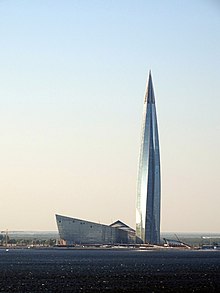
Gazprom’s headquarters in the Lakhta Center in Saint Petersburg, the tallest building in Europe. |
|
|
Native name |
ПАО «Газпром» |
|---|---|
| Type | Public (PAO) |
|
Traded as |
|
| Industry | Oil and gas |
| Founded | 8 August 1989; 33 years ago |
| Headquarters |
Saint Petersburg , Russia |
|
Key people |
|
| Products | Petroleum Natural gas Petrochemicals |
| Services | Gas pipeline transport |
| Revenue | $87.7 billion[1] (2020) |
|
Operating income |
$8.53 billion[1] (2020) |
|
Net income |
$2.25 billion[1] (2020) |
| Total assets | $324 billion[1] (2020) |
| Total equity | $205 billion[1] (2020) |
| Owner | Russian government (50.23%) |
|
Number of employees |
466,000[2] (2018) |
| Subsidiaries | List of subsidiaries |
| Website | gazprom.com |
PJSC Gazprom (Russian: Газпром, IPA: [ɡɐzˈprom]) is a Russian majority state-owned multinational energy corporation headquartered in the Lakhta Center in Saint Petersburg.[3] As of 2019, with sales over $120 billion, it was ranked as the largest publicly listed natural gas company in the world and the largest company in Russia by revenue.[4][5] In the 2020 Forbes Global 2000, Gazprom was ranked as the 32nd largest public company in the world.[6] The Gazprom name is a contraction of the Russian words gazovaya promyshlennost (газовая промышленность, gas industry). In January 2022, Gazprom displaced Sberbank from the first place in the list of the largest companies in Russia by market capitalization.[7] At present (in 2023), the company is delisted from international markets, and continues substantial construction in its operational results (such as production, export).
Gazprom is vertically integrated and is active in every area of the gas industry, including exploration and production, refining, transport, distribution and marketing, and power generation.[8] In 2018, Gazprom produced twelve percent of the global output of natural gas, producing 497.6 billion cubic meters of natural and associated gas and 15.9 million tonnes of gas condensate.[9] Gazprom then exports the gas through pipelines that the company builds and owns across Russia and abroad such as Nord Stream 1 and TurkStream.[10] In the same year, Gazprom has proven reserves of 35.1 trillion cubic meters of gas and 1.6 billion tons of gas condensate.[9] Gazprom is also a large oil producer through its subsidiary Gazprom Neft, producing about 41 million tons of oil with reserves amounting to 2 billion tons.[9] The company also has subsidiaries in industrial sectors including finance, media and aviation, and majority stakes in other companies.
Gazprom was created in 1989, when the Soviet Ministry of Gas Industry was converted to a corporation, becoming the first state-run corporate enterprise in the Soviet Union. After the Soviet Union’s dissolution, Gazprom was privatized, retaining its Russia-based assets. At that time, Gazprom evaded taxes and state regulation and engaged in asset stripping. The company later returned to government control in the early 2000s, and since then, the company is involved in the Russian government’s diplomatic efforts, setting of gas prices, and access to pipelines.[11]
The company is majority-owned by the Russian government, via the Federal Agency for State Property Management and Rosneftegaz, while remaining shares are traded publicly.[12] Gazprom has a listing in the Moscow Exchange and had a market capitalization of US$80.56 billion as of September 2019.[4]
History[edit]
Origins[edit]
In 1943, during World War II, the government of the Soviet Union developed a domestic gas industry. In 1965, it centralized gas exploration, development, and distribution within the Ministry of Gas Industry. In the 1970s and 1980s, the Ministry of Gas Industry found large natural gas reserves in Siberia, the Ural region and the Volga Region. The Soviet Union became a major gas producer.[13] In August 1989, under the leadership of minister of Gas Industry of the Soviet Union (1985-1989) Viktor Chernomyrdin, the Ministry of Gas Industry was renamed the State Gas Concern Gazprom, and became the Soviet Union’s first state run corporate enterprise.[14][15] In late 1991, when the Soviet Union dissolved, gas industry assets were transferred to newly established national companies, such as Naftogaz and Turkmengaz.[16] Gazprom kept assets located in Russia and secured a monopoly in the gas sector.[15]
Privatization[edit]
In December 1992, when Boris Yeltsin, the Russian President, appointed Viktor Chernomyrdin, Gazprom’s Chairman, his Prime Minister, the company’s political influence increased. Rem Viakhirev took the chairmanship of Gazprom’s Board of Directors and Managing Committee.[15] Following the Decree of the President of the Russian Federation of 5 November 1992, and the Resolution of the Government of Russia of 17 February 1993, Gazprom became a joint-stock company. Gazprom began to distribute shares under the voucher method. (Each Russian citizen received vouchers to purchase shares of formerly state-owned companies). By 1994, 33% of Gazprom’s shares had been bought by 747,000 members of the public, mostly in exchange for vouchers. Fifteen percent of the stock was allocated to Gazprom employees. The state retained 40% of the shares. That amount was gradually lowered to thirty-eight percent.[15] Trading of Gazprom’s shares was heavily regulated. Foreigners were prohibited from owning more than nine-percent of the shares. In October 1996, 1% of Gazprom’s equity was offered for sale to foreigners as Global Depository Receipts. In 1997, Gazprom offered a bond issue of US$2.5 billion.
Chernomyrdin, as Prime Minister of Russia, ensured Gazprom avoided tight state regulation. Gazprom evaded taxes, and the Government of Russia received little in dividends. Gazprom managers and board members, such as Chernomyrdin and the Gazprom Chief Executive Officer, Rem Viakhirev, engaged in asset-stripping. Gazprom assets were shared amongst their relatives. Itera, a gas trading company also received Gazprom assets.[17] In March 1998, for reasons unrelated to his activities at Gazprom, Chernomyrdin was fired by Yeltsin.[18] On 30 June 1998, Chernomyrdin was made Chairman of the Board of Directors of Gazprom.
State control[edit]
Major Russian natural gas basins in 2000
When, in June 2000, Vladimir Putin became the President of Russia, he acted to gain control over Russia’s oligarchs, and increase the Government of Russia’s control in important companies through a program of national champions.[19] Putin fired Chernomyrdin from his position as the Chairman of the Gazprom board. The Russian Government’s stock in Gazprom gave Putin the power to vote out Vyakhirev. Chernomyrdin and Vyakhirev were replaced by Dmitry Medvedev and Alexei Miller. They were Putin’s prior employees in Saint Petersburg.[19] Putin’s actions were aided by the shareholder activism of Hermitage Capital Management Chief Executive Officer William Browder, and the former Russian Finance Minister Boris Fyodorov. Miller and Medvedev were to stop asset stripping at Gazprom and to recover losses. Itera was denied access to Gazprom’s pipelines and came close to bankruptcy. Itera agreed to return stolen assets to Gazprom for a fee.[20]
In April 2001, Gazprom acquired NTV, Russia’s only nationwide state-independent television station from Vladimir Gusinsky’s company, Media-Most holdings.[21][22][23]
In 2002, the Gazprom subsidiary Gazprom Media acquired all of Gusinsky’s shares in companies held by Media-Most.[24]
In June 2005, Gazprombank, Gazpromivest Holding, Gazfond and Gazprom Finance B. V., subsidiaries of Gazprom, sold a 10.7399% share of their stock for $7 billion to Rosneftegaz [ru], a state owned company. Some analysts said the amount paid by Rosneftegaz for the stock was too low.[25] The sale was completed by 25 December 2005. With the purchased stock and the thirty-eight percent share held by the State Property Committee, the Government of Russia gained control of Gazprom.[26] The Government of Russia revoked the Gazprom twenty percent foreign ownership rule and the company became open to foreign investment.[27][28] In September 2005, Gazprom bought 72.633 percent of the oil company Sibneft for $13.01 billion. Sibneft was renamed Gazprom Neft. The purchase was aided by a $12 billion loan. Gazprom became Russia’s largest company.[29] On the day of the deal the company worth was valued at £69.7 billion (US$123.2 billion).
Countries dependent on Russian natural gas (2006)
On 5 July 2006, the Federal Law, On Gas Export, was passed, nearly unanimously, by the State Duma and on 7 July 2006, by the Federation Council. On 18 July Putin signed the new legislation and on 20 July 2006, the law was published. It gave Gazprom the exclusive right to export natural gas from Russia.[30][31][32][33] In December 2006, Gazprom signed an agreement with Royal Dutch Shell, Mitsui and Mitsubishi, to take over fifty percent plus one share of Sakhalin Energy.[34]
In June 2007, TNK-BP, a subsidiary of BP plc, agreed to sell its stake in Kovykta field in Siberia to Gazprom after the Government of Russia questioned BP’s right to export gas from Russia.[35][36][37][38]
On 23 June 2007, the governments of Russia and Italy signed a memorandum of understanding towards a joint venture between Gazprom and Eni SpA to construct a 558-mile (900 km) gas pipeline to carry 1.05 trillion cubic feet (30 km3) gas per year from Russia to Europe. This South Stream pipeline would extend under the Black Sea to Bulgaria with a south fork to Italy and a north fork to Hungary.[39][40][41] On 1 December 2007, during a visit to Turkey, Putin said the project would not proceed and 63 billion cubic metres per year (bcm/y) of gas would be shipped to Turkey instead of Bulgaria. Bulgaria was being sued by the European Union for signing a contract with Russia, which was not aligned with European Union regulations. The president of Bulgaria, Rosen Plevneliev, pressured the European Union and Russia to quickly resolve the matter.[42][43]
Continual rise[edit]
The ceremony marking the opening of a LNG production plant built as part of the Sakhalin-II project.
On 4 September 2012, the European Commission announced an anti-trust investigation into Gazprom’s activities. This was based on «concerns that Gazprom may be abusing its dominant market position in upstream gas supply markets.»[44] In late November 2013, Gazprom expanded its media interests by acquiring Profmedia from Vladimir Potanin.[45]
On 21 May 2014, in Shanghai, Gazprom and the China National Petroleum Corporation made a contract worth $400 billion over thirty years. The contract was for Gazprom to deliver 38 billion cubic meters of natural gas per year to China beginning in 2018.[46][47] In August 2014, construction began with pipes for the Power of Siberia pipeline delivered to Lensk, Yakutia.[48] Russia will start supplying natural gas to China through the Power of Siberia pipeline on 20 December 2019 as part of the two countries’ $400 billion energy pact. Beijing and Moscow are now negotiating over a second Far Eastern gas pipeline.[49][needs update]
In June 2014, Gazprom negotiated with the International Petroleum Investment Company (IPIC of Abu Dhabi) over a 24.9 percent stake in the Austrian oil and gas firm OMV.[50] In July 2014, Gazprom acquired Central Partnership, one of the largest film distributors in Russia.[51]
Supply and reserves[edit]
Production[edit]
In 2011,[needs update] Gazprom produced 513.17 billion cubic metres (18.122 trillion cubic feet) of natural gas, which was 17 percent of the worldwide production and 83 percent of Russian production. Of this amount, the Yamburg subsidiary produced 41 percent, Urengoy 23.6 percent, Nadym 10.9 percent, Noyabrsk 9.3 percent and others 15.2 percent. In addition, the company produced 32.28 million tons of oil and 12.07 million tons of gas condensate.[52][53][54]
The majority of Gazprom’s fields are located in the Nadym-Pur-Taz region (near the Gulf of Ob) in Yamalo-Nenets Autonomous Okrug in Western Siberia.[55] Historically, the three largest fields are Medvezhe, Urengoy and Yamburg.[56][57] After more than twenty years of production, the fields are now in decline. Production from the fields has decreased by twenty to twenty-five bcm per year.[58][59] The production at Zaporliarnoe, Gazprom’s fourth largest field, increased until 2004, offsetting the decline in the other fields.[58] Since 2004, Gazprom has maintained production by activating new smaller fields and by purchasing production assets from other companies.[58][60]
Gazprom Neft produces crude oil. In 2005, Gazprom purchased 75 percent of the Gazprom Neft shares for $13.1 billion.[61]
| billion cubic metres | 2004 | 2005 | 2006 | 2007 | 2008 | 2009 | 2010 | 2011 | 2012 | 2013 | 2014 | 2015 | 2016 |
|---|---|---|---|---|---|---|---|---|---|---|---|---|---|
| Natural gas | 552.5 | 555.0 | 556.0 | 548.6 | 549.7 | 461.5 | 508.6 | 513.2 | 487.0 | 487.4 | 443.9 | 418.5 | 419.1 |
| million tons | 2004 | 2005 | 2006 | 2007 | 2008 | 2009 | 2010 | 2011 | 2012 | 2013 | 2014 | 2015 | 2016 |
| Crude oil | 0.9 | 9.5 | 34.0 | 34.0 | 32.0 | 31.6 | 32.0 | 32.3 | 33.3 | 33.8 | 35.3 | 36.0 | 39.3 |
| Condensate | 11.1 | 11.5 | 11.4 | 11.3 | 10.9 | 10.1 | 11.3 | 12.1 | 12.9 | 14.7 | 14.5 | 15.3 | 15.9 |
| Source: Gazprom in figures 2004–2008, 2007–2011, 2009–2013 and 2012–2016.[52][53][54][62] |
Imports from Central Asia[edit]
Gazprom’s ability to supply natural gas to domestic market and for reexport has relied to a large extent on imports from Central Asia.[57][58] In 2007, Gazprom imported a total of 60.7 billion cubic metres (2.14 trillion cubic feet) from Central Asia: 42.6 billion cubic metres (1.50 trillion cubic feet) from Turkmenistan, 8.5 billion cubic metres (300 billion cubic feet) from Kazakhstan, and 9.6 billion cubic metres (340 billion cubic feet) from Uzbekistan.[58] In particular, Gazprom purchased seventy-five percent of Turkmenistan gas exports in order to supply gas to Ukraine. In 2008, Gazprom paid $130/mcm to $180/mcm for gas from Central Asia.[58]
Reserves[edit]
In 2015, Gazprom’s proved and probable reserves of natural gas were 23.705 trillion cubic metres (837.1 trillion cubic feet), a 3.8% increase from the 2011 figure which represented 18.4% of the world’s reserves. In 2015, the reserves of crude oil were 1.355 billion tons and the reserves of gas condensate were 933.3 billion tons.[52][63] 59.8 percent of Gazprom’s natural gas reserves (Categories A+B+C1) were located in the Urals Federal District (decreasing), 20.5 percent in the Arctic shelf (increasing), and 8.3 percent in the Southern Federal District and North Caucasus Federal District.[52][53]
| trillion cubic metres | 2004 | 2005 | 2006 | 2007 | 2008 | 2009 | 2010 | 2011 | 2012 | 2013 | 2014 | 2015 |
|---|---|---|---|---|---|---|---|---|---|---|---|---|
| Natural gas | 20.90 | 20.66 | 20.73 | 20.84 | 21.28 | 21.95 | 22.52 | 22.84 | 23.39 | 23.26 | 23.51 | 23.71 |
| Source: Gazprom in figures 2004–2008, 2007–2011 and 2009–2013.[52][53][54] |
Development and exploration[edit]
Location of the Shtokman gas field
Gazprom has invested about 480 billion rubles ($20 billion) in new major projects in order to maintain supply.[58][60] Nearly 37 percent of Gazprom’s reserves are located in the Yamal Peninsula and in the Barents Sea.[57]
Blue Stream Pipeline[edit]
One of Gazprom’s major projects is the Blue Stream Pipeline.[64] The Blue Stream Pipeline delivers natural gas to Turkey via the Black Sea. In 1997, the Blue Stream Pipeline agreement between Turkey and Russia was signed. In 2000, the first joint was welded. The pipeline has transported 16 billion cubic meters each year.[64]
Yamal Peninsula[edit]
Exploration of the Yamal peninsula has found reserves of over 10 trillion cubic metres of natural gas and over 500 million tons of oil and gas condensate. About 60 percent of these reserves are located in Bovanenkovo, Kharasavey and Novoportovo. The natural gas production capacity of the Bovanenkovo field was estimated to be 115 billion cubic metres per annum (4.1 trillion cubic feet per annum), with potential to increase to 140 billion cubic metres per annum (4.9 trillion cubic feet per annum).[52]
Shtokman field[edit]
The Shtokman field is one of the world’s largest natural gas fields. It is located in the central part of the Barents Sea, 650 kilometres (400 mi) northeast of the city of Murmansk and 1,000 kilometres (620 mi) west of the Yamal Peninsula. The field is estimated to contain up to 3.7 trillion cubic metres (130 trillion cubic feet) of gas.[58] Potential production is 71 billion cubic metres per annum (2.5 trillion cubic feet per annum) in the initial phases, with a potential increase to 95 billion cubic metres per annum (3.4 trillion cubic feet per annum).[52] Gazprom, TotalEnergies (France) and Statoil (Norway) created a joint company Shtokman Development AG for development of the field.[65][66][67]
Khanty-Mansiysk autonomous area (Arctic shelf)[edit]
On 8 April 2013, in Amsterdam, Alexey Miller, chairman of the Gazprom management committee, and Jorma Ollila, chairman of the board of directors of Royal Dutch Shell, signed in the presence of Putin and Mark Rutte, prime minister of the Netherlands, a memorandum outlining the principles of cooperation within hydrocarbons exploration and development in the Arctic shelf and a section of the deep-water shelf.
[68]
Exploration[edit]
In 2008, Gazprom carried out 284.9 kilometres (177.0 mi) of explorative well drilling; 124,000 kilometres (77,000 mi) of 2D seismic and 6,600 square kilometres (2,500 sq mi) of 3D seismic survey. As a result, gas reserves grew by 583.4 billion cubic metres (20.60 trillion cubic feet), and crude oil and gas condensate reserves grew by 61 million tons.
Gazprom carries out prospecting and exploration in foreign countries such as India, Pakistan, Algeria, Venezuela, Vietnam, Libya, Kazakhstan, Uzbekistan, Kyrgyzstan and Tajikistan.[52]
Transportation[edit]
Natural gas pipelines from Russia to Europe in 2009
Gazprom’s Unified Gas Supply System (UGSS) includes 158,200 kilometres (98,300 mi) of gas trunklines and branches and 218 compressor stations with a 41.4 GW capacity. The UGSS is the largest gas transmission system in the world.[69] In 2008, the transportation system carried 714.3 billion cubic metres (25.23 trillion cubic feet) of gas.[52] Gazprom has claimed the UGSS has reached its capacity.[69] Major transmission projects include the Nord Stream pipelines as well as pipelines inside Russia.[52]
Russia has two liquefied natural gas (LNG) production plants, Yamal LNG and Sakhalin-2 LNG. In March 2021, the Russian Government authorised a long-term programme to develop nine more LNG plants, to address the growing global LNG market.[70] In October 2021, Gazprom and RusGazDobycha announced they would build the first new plant at Ust-Luga, with access to the Baltic Sea for sea transportation westward. It would process ethane-containing natural gas with a capacity of 13 million tons of LNG per year.[71][72]
Sales[edit]
In 2006, Gazprom sold 316 billion cubic metres (11.2 trillion cubic feet) of gas to domestic customers; 162 billion cubic metres (5.7 trillion cubic feet) to the rest of Europe; and 101 billion cubic metres (3.6 trillion cubic feet) to CIS countries and the Baltic states.[58] Gazprom receives about 60 percent of its revenue from its sales to European customers.[73] In 2008, the average gas price paid by Russian industrial customers was $71/mcm, while households paid $54/mcm.[58]
| Gazprom sales of gas 2004–2008 in mega cubic meters (mcm) | ||||||||||
|---|---|---|---|---|---|---|---|---|---|---|
| Region | 2004 | 2005 | 2006 | 2007 | 2008 | |||||
| Volume | Price | Volume | Price | Volume | Price | Volume | Price | Volume | Price | |
| Russia | 306 bcm | $47/mcm | 307 bcm | $36/mcm | 316 bcm | $43/mcm | 307 bcm | $42/mcm | 287 bcm | $67/mcm |
| CIS+Baltic | 66 bcm | $36.33/mcm | 77 bcm | $50.02/mcm | 101 bcm | $76.37/mcm | 100 bcm | $91.6/mcm | 96.5 bcm | $118/mcm |
| Europe | 153 bcm | $101.61/mcm | 156 bcm | $140.09/mcm | 162 bcm | $192.59/mcm | 168.5 bcm | $185/mcm | 184.4 bcm | $313/mcm |
| Prices are excluding VAT and tax and custom duties. Sources:[58][74] |
Since 2000, Natural gas prices have fluctuated. In late 2007, the price of natural gas at the New York NYMEX was $7.53 per million British thermal units ($25.7/MWh). At a conversion of 26,4 m³ per million Btu it would correspond to a price of $285 per 1,000 cubic metres. At the same time, based on their respective contracts with Gazprom, German customers paid $250 per cubic metre (m3), Polish customers $290 per m3, Ukraine customers $130 per m3 and Russian customers $49 per m3.[75]
Exports[edit]
Gazprom delivered gas to 25 European countries. Its main export arm is Gazprom Export LLC, founded in 1973 and before 1 November 2006 known as Gazexport, which has a monopoly on gas exports to countries outside of the former Soviet Union. The majority of Russian gas in Europe is sold on 25-year contracts.[58] In late 2004, Gazprom was the sole gas supplier to Bosnia and Herzegovina, Estonia, Finland, Macedonia, Latvia, Lithuania, Moldova, Serbia and Slovakia. It provided 97 percent of Bulgaria’s gas, 89 percent of Hungary’s gas, 86 percent of Poland’s gas, nearly 75 percent of the Czech Republic’s, 67 percent of Turkey’s, 65 percent of Austria’s, about 40 percent of Romania’s, 36 percent of Germany’s, 27 percent of Italy’s, and 25 percent of France’s gas.[79][80] The European Union received about 25 percent of its gas supply from Gazprom.[81][82] In 2006, Gazprom entered several long term gas contracts with European companies.[83] The contract prices were mainly linked to oil prices.[84]
In 2014, Europe was the source of 40% of Gazprom’s revenue. The proportion of Europe’s gas bought in the spot market rose from 15 percent in 2008 to 44 percent in 2012.[85]
In September 2013, during the G20 summit, Gazprom signed an agreement with CNPC that the Henry Hub index would not be used to settle prices for their trades.[86] On 21 May 2014, Putin met with Xi Jinping and negotiated a $400bn deal between Gazprom and CNPC.[87] Under the contract, Russia was to supply 38 billion cubic meters of gas annually over 30 years at a cost of $350 per thousand cubic meters beginning in 2018. During the first half of 2018, Gazprom increased its export about 8.7%.[citation needed] In 2013, the average price of Gazprom’s gas in Europe was about $380 per thousand cubic meters.[87] China offered a loan of about $50bn to finance development of the gas fields and the construction of the pipeline by Russia up to the Chinese border, with the Chinese to build the remaining pipeline.[87]
In January 2023, as a result of the sanctions imposed on Russia in 2022, Gazprom announced its exports of gas fell 45% from 185Bcm to 101Bcm, mainly due to the loss of the European market.[88]
Price disputes[edit]
On 1 January 2006, at 10:00 (Moscow time), during the Russia-Ukraine gas dispute, Gazprom ceased the supply of gas to the Ukrainian market. Gazprom called on the government of Ukraine to increase its payment for natural gas in line with increases in global fuel prices. During the night of 3 January 2006, and early morning of 4 January 2006, Naftogas of Ukraine and Gazprom negotiated a deal that temporarily[89] resolved the long-standing gas price conflict between Russia and Ukraine.
On 3 April 2006, Gazprom announced it would triple the price of natural gas to Belarus after 31 December 2006. In December 2006, Gazprom threatened to cease supply of gas to Belarus at 10 am Moscow time on 1 January 2007, unless Belarus increased payments from $47 to $200 per 1,000 cubic metres or to cede control over its distribution network.[90] Some analysts suggested Moscow was penalising Alexander Lukashenko, the President of Belarus, for not delivering on pledges of closer integration with Russia,[91] while others noted that other countries like Armenia were paying as much for their gas as Belarus would with the new price levels.[92]
Gazprom later requested a price of $105,[93] yet Belarus still refused the agreement. Belarus responded that if supplies were cut, it would deny Gazprom access to its pipelines, which would impair gas transportation to Europe.[94] However, on 1 January 2007, just a few hours before the deadline, Belarus and Gazprom signed a last-minute agreement. Under the agreement, Belarus undertook to pay $100 per 1,000 cubic metre in 2007. The agreement also allowed Gazprom to purchase 50 percent of the shares in Beltransgaz, the Belarusian pipeline network.[95] Immediately following the signing of this agreement, Belarus declared a $42/ton transportation tax on Russian oil travelling through the Gazprom pipelines crossing its territory.
On 13 March 2008, after a three-day period where gas supplies to Ukraine were halved, Gazprom agreed to supply Ukraine with gas for the rest of the year. The contract removed intermediary companies.[96]
On 1 April 2014, Gazprom increased the gas price charged to Ukraine from $268.50 to $385.50 (£231.00) per 1,000 cubic metres. Ukraine’s unpaid gas bills to Russia stood at $1.7bn (£1.02bn).[97] On 30 October 2014, Russia agreed to resume gas supplies to Ukraine over the winter in a deal brokered by the European Union.[98]
Corporate affairs[edit]
Gazprom is a vertically integrated company, one which owns its supply and distribution activities.[99] Gazprom owns all its main gas processing facilities in Russia. It operates Russia’s high pressure gas pipelines and since 2006, it has held a legal export monopoly. Other natural gas producers, such as Novatek, Russia’s second largest gas company, are forced to use Gazprom’s facilities for processing and transport of natural gas.[73][100]
19th conference of Gazprom’s young scientists in Tyumen in 2016
At the end of 2008, Gazprom had 221,300 employees in its major gas production, transportation, underground storage and processing subsidiaries. Of these employees, 9.5 percent were in management, 22.9 percent were specialists, 63.4 percent were workers and 4.2 percent were other employees.[52] Gazprom’s headquarters were in the Cheryomushki District, South-Western Administrative Okrug, Moscow[101] until 2021, when they moved to the Lakhta Centre in Saint Petersburg.[102]
Gazprom is a national champion, a concept advocated by Putin, in which large companies in strategic sectors are expected not only to seek profit, but also to advance Russia’s national interests. For example, Gazprom sells gas to its domestic market at a price less than that of the global market.[15] In 2008, Gazprom’s activities made up 10 percent of the Russian gross domestic product[52]
Due to its large projects, including international pipes like Nord Stream 1 and Turkish Stream, Gazprom is a substantial source of revenue for several domestic suppliers and contractors.[103]
Shareholders[edit]
As of 2017, Gazprom’s main shareholders were the Federal Agency for State Property Management with 38.37% and Rosneftegaz with 10.97%.[12] Together with a 0.89 share of Rosgazifikatsiya, they guaranteed a majority control of the company by the Russian government. The rest of the shares were held by investors, including 25.20% by ADR holders on foreign stock markets, and 24.57% by other legal entities and individuals.[12]
Gazprom is listed on the stock markets of Moscow, Karachi. It is the top component of the MICEX and RTS indices.[104] Gazprom used to be listed on the London, Berlin, Frankfurt and Singapore markets before the 2022 sanctions.[105]
Subsidiaries[edit]
Gazprom has several hundred subsidiaries in Russia and abroad which are owned and controlled directly or indirectly by the company.
Management[edit]
Gazprom’s Board of Directors as of 9 August 2015:[106]
- Viktor Zubkov (Chairman, Russian Special Presidential Representative for Cooperation with Gas Exporting Countries Forum, First Deputy Prime Minister of Russia, former Prime Minister of Russia)
- Alexey Miller (Deputy Chairman, Chairman of the Management Committee, CEO, Chairman of Gazprombank, former Deputy Minister of Energy of Russia)
- Andrey Akimov (Chairman of Gazprombank)
- Farit Gazizullin (former Minister of State Property of Russia, former Minister of Property Relations of Russia)
- Timur Kulibaev (Chairman of Legal Entities Department)
- Vitaly Markelov (Deputy Chairman of the Management Committee)
- Viktor Martynov (Rector of Gubkin Russian State University of Oil and Gas, Professor)
- Vladimir Mau (Rector of the Russian Presidential Academy of National Economy and Public Administration)
- Valery Musin (Head of the Civil Procedure Department, Faculty of Law, Saint Petersburg State University)
- Alexander Novak (Minister of Energy of the Russian Federation)
- Mikhail Sereda (Deputy Chairman of the Management Committee, Head of the Administration of the Management Committee of Gazprom)
Gazprom’s management committee as of December 2006:[107]
- Alexei Miller (Chairman, Deputy Chairman of the Board, CEO, Chairman of Gazprombank, former Deputy Minister of Energy of Russia, member since 2001)
- Alexander Ananenkov (Deputy Chairman, Deputy Chairman of the Board, Gazprom shareholder, member since 17 December 2001)
- Valery Golubev (Deputy Chairman, Head of the Department for Construction and Investment, former Head of the Vasileostrovsky District, former member of the Federation Council of Russia, member since 18 April 2003)
- Alexander Kozlov (Deputy Chairman, member since 18 March 2005)
- Andrey Kruglov (Deputy Chairman, Head of the Department for Finance and Economics, member since 2002)
- Alexander Medvedev (Deputy Chairman, Deputy Chairman of the Board, former Director General of Gazprom Export, President of Kontinental Hockey League, member of the Coordination Committee of RosUkrEnergo, member since 2002)
- Mikhail Sereda (Deputy Chairman, Head of Administration, Deputy Chairman of Gazprombank, member since 28 September 2004)
- Sergei Ushakov (Deputy Chairman, member since 18 April 2003)
- Elena Vasilyeva (Deputy Chairman, Chief Accountant, member since 2001)
- Bogdan Budzulyak (Head of the Department of Gas Transportation, Underground Storage and Utilization, member since 1989)
- Nikolai Dubik (Head of Legal Department, member since 2008)
- Konstantin Chuychenko (Head of the Control Department of Russia, presidential aide to Dmitry Medvedev, former chairman of Gazprom Media, executive director of RosUkrEnergo, former KGB officer, member since 2002)
- Viktor Ilyushin (Head of the Department of Relationships with Regional Authorities of the Russian Federation, member since 1997)
- Olga Pavlova (Head of the Department of Asset Management and Corporate Relations, member since 2004)
- Vasiliy Podyuk (Head of the Department of Gas, Gas Condensate and Oil Production, member since 1997)
- Vlada Rusakova (Head of the Department of Strategic Development, member since 5 September 2003)
- Kirill Seleznev (Head of the Department of Marketing and Processing of Gas and Liquid Hydrocarbons, member since 27 September 2002, Director-General of Mezhregiongaz)
[edit]
Gazprom is the owner and sponsor of the Russian Premier League football club FC Zenit Saint Petersburg and its other sporting departments (Basketball and volleyball), as well as volleyball club VC Zenit-Kazan and Gazprom-Ugra Surgut at Russian Volleyball Super League.
On 1 January 2007, Gazprom became the sponsor of the German Bundesliga club FC Schalke 04 at a cost of up to €25 million per year. On 23 November 2009, the partnership was extended for a further five years. Schalke then suspended their sponsorship of Gazprom after the Russian invasion of Ukraine. The sponsorship was worth $150m (USD) over five years.[108]
On 9 July 2010, Gazprom became a sponsor of the Serbian SuperLiga football club Red Star Belgrade. In 2010, Gazprom was a Gold Partner of the Russian professional cycling team, Team Katusha, together with Itera, and Russian Technologies (Rostekhnologii).
On 17 July 2012, Gazprom became the official Global Energy partner of the UEFA Champions League 2012 winners Chelsea. The sponsorship continued for three years to 2015.[109]
In September 2013, Gazprom became an official partner of FIFA tournaments from 2015 to 2018. The contract includes the 2018 FIFA World Cup in Russia.[110]
Gazprom also was a sponsor for the defunct-Minardi F1 team in 2002–2003.
Gazprom owns SKA St Petersburg of the KHL.
On 9 July 2012, Gazprom became a sponsor of the UEFA Champions League and UEFA Super Cup. The sponsorship continued for three seasons until 2015. In 2021, the partnership was also extended until 2024. the company also serves as the global partner for UEFA Euro 2020 and 2024, however due to the Russian invasion of Ukraine, Gazprom’s sponsorship for Champions League and Euro 2024 was cut, marking the end of their 10 year partnership with UEFA.[111]
Environmental record[edit]
According to geographer Richard Heede,[112] Gazprom is second on the list of companies with the highest level of CO2 emissions globally in 2013, with 1,135 million tonnes (1.117×109 long tons; 1.251×109 short tons) in 2013, amounting to almost 3.4% of worldwide anthropogenic emissions.[113]
Controversies[edit]
Geopolitical leverage[edit]
Repeatedly, Gazprom has been accused of being a political and economical weapon of Russia, using the supply and price of natural gas to gain control over Europe and most noteworthy, Ukraine.[114][115] “Regardless of how the stand-off over Ukraine develops, one lesson is clear: excessive dependence on Russian energy makes Europe weak,” said Donald Tusk, former prime minister of Poland in April 2014.[116] The friction resulted in two boycott campaigns in Ukraine, one that started in 2005, the other in 2013. Russia denies weaponizing energy via Gazprom.[117] In December 2019, Gazprom paid $2.9 billion to Ukrainian counterpart Naftogaz as ordered by a Stockholm court ruling’s award on damage claims stemming from alleged economical harassment.[118]
In the wake of the 2022 Russian Invasion of Ukraine Gazprom had issues with many EU countries, and stated it would cut off supplies to French energy supplier, Engie, over failure to pay in full for deliveries. This was disputed, with France’s Energy Transition Minister Agnes Pannier-Runacher stating, «Very clearly Russia is using gas as a weapon of war and we must prepare for the worst case scenario of a complete interruption of supplies.»[119]
Yukos Oil fraud[edit]
Yuganskneftegaz was the core production subsidiary of the Yukos Oil Company, which was previously run by a Russian businessman, Mikhail Khodorkovsky. In 2003, the Russian tax authorities charged Yukos and Khodorkovsky with tax evasion. On 14 April 2004, Yukos was presented with a bill for over US$35 bn in back taxes and a demand to pay the entire bill the same day. Requests by Yukos to defer payment, allow payment by installments or to discharge the debt by sale of peripheral assets, including its shareholding in the Sibneft oil company, were also refused.
The bailiffs froze Yukos’ shares in Yuganskneftegaz and on 19 November 2004, they placed a notice in the Russian government newspaper Rossiyskaya Gazeta. Yuganskneftegaz would be sold at an auction thirty days later on 19 December 2004.[120] The conditions for participation in the auction included an advance deposit of US$1.7 bn and prior clearance by the Russian Federal Antimonopoly Service. In early December 2004, Gazprom submitted an application to participate in the auction via its wholly owned subsidiary, Gazpromneft.
On 15 December 2004, Yukos filed for bankruptcy protection in a Houston court and obtained a temporary injunction prohibiting Gazprom from participating in the auction. On 16 December 2004, a group of Western banks withdrew their financial support for Gazprom’s application. On the same day, Baikalfinansgrup, a previously unknown company, applied to participate in the auction.
On 19 December 2004, only two companies appeared at the auction, Gazpromneft and Baikalfinansgrup. Gazpromneft declined to place any offer. Baikalfinansgrup acquired Yuganskneftegaz on its first bid. On 23 December 2004, Baikalfinansgrup was acquired by Rosneft. Rosneft later disclosed in its annual financial statement that it had financed the acquisition of Yuganskneftegaz.[121] At the time, Sergey Bogdanchikov was the president of Rosneft and the chief executive officer of Gazpromneft.[122]
Shortly after the auction, the planned merger between Gazprom and Rosneft was abandoned, and Bogdanchikov resigned his post as chief executive officer of Gazpromneft.
On 7 February 2006, in response to a question by a Spanish journalist, Vladimir Putin disclosed that Rosneft had used Baikalfinansgrup as a vehicle to acquire Yuganskneftegaz in order to protect itself against litigation.[123]
Antitrust[edit]
On 22 April 2015, Gazprom was charged by the European Commission with using territorial restrictions to engage in anticompetitive behavior and using its dominant position to impose unfair prices.[124] The company was accused of preventing competition in Bulgaria, the Czech Republic, Estonia, Hungary, Latvia, Lithuania, Poland and Slovakia.[125] The territorial restrictions prevented the import of gas at potentially more competitive prices.[126] The restrictions also prevented gas from reaching areas of high demand and avoiding areas of excessive supply. Gazprom was also accused of compelling entities to consent to the now defunct South Stream pipeline by necessitating a consent clause in long term contracts.[124]
In 2018, Gazprom agreed to a settlement which involved dropping all contractual barriers to the free flow of gas in Central and Eastern European gas markets and to take various steps to improve economic cooperation.[125][127] Customers would be given an explicit contractual right to trigger a price review when prices paid diverged from competitive price benchmarks, and be allowed more frequent and efficient price reviews. Gazprom agreed to not seek any damages from its Bulgarian partners following the termination of the South Stream project. Had the case gone to court, the company could have been forced to pay fines of up to $12 billion.[124]
In 2020, Gazprom agreed to reimburse Poland’s PGNiG close to $1.5 billion for years of compelling it to overpay for its gas supply.[128]
Methane leaks[edit]
In June 2021, a massive methane plume over Russia resulted from the partial shutdown of a Gazprom PJSC pipeline for emergency repair. The company said the repairs, which took place on 4 June, released 2.7 million cubic meters (1,830 metric tons) of methane. That amount has roughly the same short term planet-warming impact of 40,000 internal-combustion cars in the U.S. driving for a year, according to the Environmental Defense Fund. The climate warming effect of methane is judged to be 86-times more powerful than carbon dioxide.[129][130]
Nord Stream pipelines[edit]
Nord Stream is a system of offshore natural gas pipelines in Europe, running under the Baltic Sea from Russia to Germany. The pipelines are owned and operated by subsidiaries of Gazprom. The Nord Stream projects have been fiercely opposed by the United States and Ukraine, as well as by other Central and Eastern European countries, because of concerns that the pipelines would increase Russia’s influence in Europe, and because of the knock-on reduction of transit fees for use of the existing pipelines in Central and Eastern European countries.[131][132] German Chancellor Olaf Scholz suspended certification of Nord Stream 2 on 22 February 2022 because Vladimir Putin led Russia to recognize the Donetsk and Luhansk regions of Ukraine as independent republics.[131] On 2 March 2022, it was reported that Nord Stream 2 AG, a Gazprom subsidiary, had ended business operations and laid off all 106 members of its staff as a result of International sanctions, though earlier reports that it had filed for bankruptcy were denied.[133]
On 26 September 2022, a severe drop in pressure in both NS1 and NS2 was associated with a rupture in both pipes due to sabotage.
Greenpeace protest against Arctic drilling[edit]
Gazprom’s oil drilling in the Arctic has drawn protests from environmental groups, particularly Greenpeace. Greenpeace has opposed oil drilling in the Arctic on the grounds that oil drilling damages the Arctic ecosystem and that there are no safety plans in place to prevent oil spills.[134]
In August 2012, Greenpeace had staged protests against the Prirazlomnaya oil platform, the world’s first offshore Arctic drill site.[135][136] On 18 September 2013, the Greenpeace vessel MV Arctic Sunrise staged a protest and attempted to board Gazprom’s Prirazlomnaya oil platform, the world’s first offshore Arctic drill site. Greenpeace stated that the drill site could cause massive disruption to the Arctic ecosystem.[137] After arresting two campaigners attempting to climb the rig,[138] the Russian Coast Guard seized control of the Greenpeace ship by dropping down from a helicopter and arresting thirty Greenpeace activists. Arctic Sunrise was towed by the Russian Coast Guard to Murmansk.
The Russian government intended to charge the Greenpeace campaigners with piracy and hooliganism, which carried a maximum penalty of fifteen years imprisonment. Greenpeace argued their operatives were in international waters.[139] The Russian government’s actions generated protests from governments and environmentalists worldwide.[134][140][non-primary source needed] According to Phil Radford, Executive Director of Greenpeace in the US at the time, the reaction of the Russian coast guard and the courts were the «stiffest response that Greenpeace has encountered from a government since the bombing of the Rainbow Warrior in 1985.»[141] The charges of piracy were dropped in October 2013. In November 2013, twenty-seven of the campaigners were released on bail.[142]
In May 2014, the first shipment of Arctic oil arrived at a refinery in the Netherlands and was purchased by the French company, TotalEnergies.[143]
Sanctions[edit]
Following Russia’s continued aggression towards Ukraine, the US tightened its debt financing restrictions on Gazprombank on 17 July 2014.[144] On 12 September 2014, the United States barred U.S. persons from selling goods and services to Gazprom and Gazprom Neft.[144][145] On 31 July 2014, the EU placed financial restrictions on Gazprombank.[146] On 9 September 2014, the EU placed financial restrictions on Gazprom Neft.
In April 2018, the United States placed CEO Alexey Miller among the Specially Designated Nationals.[147] This sanction bars U.S. individuals and entities from having any dealings with him. Entities outside U.S. jurisdiction may also face punishment if the U.S. government deems they are aiding a sanctioned entity. Miller himself claimed to be proud of the sanction: “Not being included in the first list I even had some doubts – may be something is wrong (with me)? But I am finally included. This means that we are doing everything right,” Miller said through his spokesman.[148]
In December 2019, the U.S. sanctioned firms involved in the Nord Stream 2 project.[149][150]
On 24 February 2022, upon the 2022 Russian invasion of Ukraine, the U.S. expanded penalties on Nord Stream 2 AG, a subsidiary of Gazprom, and sanctioned its CEO Matthias Warnig.[151] It also expanded debt and equity prohibitions against Gazprombank, Gazprom, and Gazprom Neft.[152] In addition, following the invasion, in March 2022 the European Union formally approved a ban on investments in the Russian energy sector, including Gazprom Neft.[153] Due to economic sanctions, Gazprom took the unprecedented step of suspending dividends for the first time since 1998.[154]
On 18 July 2022, amid the Nord Stream 1 maintenance period, Gazprom sent a letter declaring force majeure, declaring that due to extraordinary circumstances it could not guarantee a gas supply. On 26 September 2022 there was a rupture in both pipes due to sabotage.
On 19 December 2022 the European Energy ministers agreed on a price cap for natural Gas at €180 per megawatt-hour[155] aiming to stop Russia forcing European gas prices upwards.
See also[edit]
- Naftogaz
- CentGas consortium
- Gazpromavia airline
- List of Russian companies
- Enerco Energy
- Lakhta Center
- Obskaya–Bovanenkovo Line
- Energy Triangle
- List of countries by natural gas production
- List of countries by natural gas exports
- List of countries by natural gas proven reserves
- 2022 Russian businessmen suspicious deaths
References[edit]
- ^ a b c d e «PJSC Gazprom IFRS Consolidated Financial Statements with Independent Auditor’s Report 31 December 2020» (PDF). Gazprom. 29 April 2021. p. 86. Retrieved 29 April 2021.
- ^ http://www.gazprom.ru/f/posts/01/851439/gazprom-accounting-report-2018.pdf.
- ^ Grant, Peter (6 June 2017). «Gazprom’s New Headquarters Towers Over All Others in Europe». The Wall Street Journal. ISSN 0099-9660. Archived from the original on 21 May 2020. Retrieved 23 February 2020.
- ^ a b Carpenter, J. William. «The Top Natural Gas Companies in the World». Investopedia. Archived from the original on 11 April 2020. Retrieved 18 February 2020.
- ^ «РБК 500: Крупнейшие компании России». РБК. Archived from the original on 16 November 2019. Retrieved 23 February 2020.
- ^ «Forbes Global 2000». Forbes. Archived from the original on 23 September 2020. Retrieved 31 October 2020.
- ^ «Сбербанк сдал строчку лидера «Газпрому»«. expert.ru. Retrieved 10 January 2022.
- ^ «Gazprom». Forbes. Archived from the original on 24 April 2020. Retrieved 23 February 2020.
- ^ a b c «Operations at Gazprom». gazprom.com. Archived from the original on 4 March 2020. Retrieved 23 February 2020.
- ^ «Transmission». gazprom.com. Archived from the original on 8 June 2020. Retrieved 23 February 2020.
- ^ Crumley (7 January 2009). «Russia’s Gazprom Diplomacy: Turning Off Europe’s Heat». Time. Archived from the original on 18 October 2015. Retrieved 25 April 2015.
- ^ a b c «Equity capital structure». Gazprom. 2018. Archived from the original on 15 September 2018. Retrieved 15 September 2018.
- ^ Kupchinsky, Roman (2 February 2012). «Gazprom – A Troubled Giant». Radio Free Europe/Radio Liberty. Archived from the original on 16 October 2012. Retrieved 14 September 2012.
- ^ «Gazprom Joint Stock Company». Gazprom. Archived from the original on 22 January 2009. Retrieved 18 October 2009.
- ^ a b c d e Goldman, Marshall I. (2008). «5». Petrostate: Putin, Power and the New Russia. Oxford University Press. ISBN 978-0-19-534073-0.
- ^ Aarentsen, Maarten (2003). National reforms in European gas.
- ^ Goldman, p.61
- ^ Goldman, p.101
- ^ a b Goldman, pp.104–105
- ^ Goldman, pp.141–142
- ^ «Russian TV station loses freedom». BBC News. 3 April 2001. Archived from the original on 8 November 2012. Retrieved 31 January 2010.
- ^ «Russian NTV viewers on the streets». BBC News. 8 April 2001. Archived from the original on 4 February 2021. Retrieved 31 January 2010.
- ^ Tremlett, Giles (24 April 2001). «Putin is out to get me, says media tycoon World news, The Guardian». The Guardian. London. Archived from the original on 4 February 2021. Retrieved 31 January 2010.
- ^ «Russian NTV handed to Gazprom». BBC News. 4 May 2001. Archived from the original on 4 February 2021. Retrieved 31 January 2010.
- ^ «Kremlin agrees price for Gazprom.» Archived 5 March 2016 at the Wayback Machine BBC News 16 June 2005.
- ^ «ОАО «Газпром» О компании / История / 2005 год». Gazprom.ru. Archived from the original on 19 March 2008. Retrieved 31 January 2010.
- ^ Jason Bush (13 January 2006). «Gazprom | Open for Global Investors». www.businessweek.com.
- ^ «Business | Gazprom opens doors to foreigners». BBC News. 24 June 2005. Archived from the original on 18 October 2015. Retrieved 28 August 2015.
- ^ Yenikeyeff, Shamil, «BP, Russian billionaires, and the Kremlin: a Power Triangle that never was» Archived 7 March 2016 at the Wayback Machine, Oxford Energy Comment, 23 November 2011. Retrieved 24 November 2011.
- ^ «Full text in Russian». Rg.ru. Archived from the original on 14 June 2009. Retrieved 31 January 2010.
- ^ Neil Buckley and Tobias Buck, «Duma votes for Russian gas export monopoly» Archived 2007-05-27 at the Wayback Machine, The Financial Times, 16 June 2006.
- ^ «Duma approves Gazprom export bill» Archived 5 March 2016 at the Wayback Machine, BBC News, 5 July 2006.
- ^ [1] Archived 2014-03-12 at the Wayback Machine
- ^ «Gazprom grabs Sakhalin gas stake». BBC. 21 December 2006. Archived from the original on 27 December 2008. Retrieved 31 December 2008.
- ^ «BP Set to Leave Russia Gas Project», by Guy Chazan and Gregory L. White, The Wall Street Journal, 23 June 2007 p. A3
- ^ «BP sells Kovykta gas field stake to Gazprom». CNN. 22 June 2007. Retrieved 29 June 2007.[dead link]
- ^ Kramer, Andrew E. (23 June 2007). «Moscow Presses BP to Sell a Big Gas Field to Gazprom». The New York Times. Archived from the original on 24 April 2009. Retrieved 29 June 2007.
- ^ «Gazprom, BP and TNK-BP enter into agreement on major terms of cooperation». Gazprom. 22 June 2007. Archived from the original on 14 May 2008. Retrieved 29 June 2007.
- ^ «Gazprom Pipeline Plan May Fuel Worry» by Gabriel Kahn, The Wall Street Journal, 25 June 2007 p. A11
- ^ «Gazprom, Eni plan big gas pipeline bypassing Turkey.» Archived 10 January 2009 at the Wayback Machine Reuters 23 June 2007 Accessed 26 June 2007.
- ^ «Eni and Gazprom sign the agreement for the South Stream Project.» Archived 17 September 2013 at the Wayback Machine Eni.it 23 June 2007 Accessed 26 June 2007.
- ^ «Russia confirms decision to abandon South Stream». EurActiv. 1 December 2014. Archived from the original on 9 September 2015. Retrieved 28 August 2015.
- ^ «Видео споделяне / VBOX7». Vbox7.com. Archived from the original on 18 October 2015. Retrieved 28 August 2015.
- ^ Naeem, Asad. «EU launches anti-trust case against Gazprom: Commission». Business Recording. Archived from the original on 17 September 2013. Retrieved 4 September 2012.
- ^ Douglas Busvine (26 November 2013). «Gazprom expands Russian media empire». Reuters. Archived from the original on 18 October 2015.
- ^ «Russia’s Putin signs 30-year gas deal with China». BBC News. 21 May 2014. Archived from the original on 11 February 2016.
- ^ «China and Russia sign $400 billion 30-year gas deal». Russia Herald. Archived from the original on 22 May 2014. Retrieved 22 May 2014.
- ^ Mitrova, Tatiana (9 September 2014). «Looking East Amid a Crisis to the West: Russia’s Energy Export Strategies». NBR Interview. Archived from the original on 13 October 2014. Retrieved 16 October 2014.
- ^ «Russia To Start Supplying Gas To China By Pipeline In December 2019». Radio Free Liberty. 5 July 2017. Archived from the original on 5 July 2017.
- ^ «Update 2 -Gazprom in talks to buy Abu Dhabi’s OMV stake-source». Archived from the original on 1 July 2014. Retrieved 27 June 2014.
- ^ «Газпром-медиа» объединяет производство на базе «Централ Партнершип». Archived from the original on 24 July 2018. Retrieved 23 July 2018.
- ^ a b c d e f g h i j k l «Gazprom in figures 2004–2008» (PDF). Gazprom. 2009. Archived (PDF) from the original on 1 January 2010. Retrieved 2 July 2009.
- ^ a b c d «Gazprom in Figures 2007–2011» (PDF). Gazprom. Archived from the original (PDF) on 3 March 2016. Retrieved 14 September 2012.
- ^ a b c «Gazprom in figures 2009–2013» (PDF). Gazprom. 2014. Archived from the original (PDF) on 2 August 2014. Retrieved 13 December 2014.
- ^ Staalesen, Atle (16 June 2022). «Russia’s biggest natural gas field is ablaze». The Barents Observer.
- ^ Söderbergh, B., Jakobsson, K., Aleklett, K., 2010. European energy security: an analysis of future Russian natural gas production and exports. Energy Policy 38 (12), 7827–7843.
- ^ a b c Lunden, Lars; Fjaertoft, Daniel; Overland, Indra; Prachakova, Alesia (1 October 2013). «Gazprom vs. other Russian gas producers: The evolution of the Russian gas sector». Energy Policy. 61: 663–670. doi:10.1016/j.enpol.2013.06.055. Archived from the original on 8 April 2018.
- ^ a b c d e f g h i j k l Stern, Jonathan P. (2009). «The Russian Gas Balance to 2015: difficult years ahead». In Simon Pirani (ed.). Russian and CIS Gas Markets and their Impact on Europe. Oxford University Press. ISBN 978-0-19-955454-6.
- ^ «Gazprom». Russia Profile. 2008. Archived from the original on 26 January 2009. Retrieved 2 July 2009.
- ^ a b «Questions and Answers: Production». Gazprom. Archived from the original on 22 January 2009. Retrieved 2 July 2009.
- ^ «Financial Times, September 28, 2005». Financial Times. 28 September 2005. Archived from the original on 13 August 2009. Retrieved 31 January 2010.
- ^ «Gazprom in figures 2012–2016» (PDF). Gazprom. 2017. Archived (PDF) from the original on 12 December 2017. Retrieved 11 December 2017.
- ^ «Gazprom in Figures 2011–2015» (PDF). Gazprom. Archived from the original (PDF) on 28 August 2017. Retrieved 1 June 2017.
- ^ a b Alves, Joao (2016). «Blue Stream». The Role of Feedback in the Formation and Evolution of Star Clusters: 18. Bibcode:2016rffe.confE..18A. Archived from the original on 30 October 2014. Retrieved 30 October 2014.
- ^ «Gazprom and Total sign a Framework Agreement For Cooperation in the First Phase of Shtokman Development». OilVoice. 13 July 2007. Archived from the original on 27 September 2007. Retrieved 18 July 2007.
- ^ «Total signs on Shtokman dotted line». Upstream Online. 13 July 2007. Archived from the original on 27 September 2007. Retrieved 13 July 2007.
- ^ «Gazprom and Statoil sign agreement on main condition for cooperation in phase 1 of Shtokman field development» (Press release). Gazprom. 25 October 2007. Archived from the original on 22 December 2007. Retrieved 26 October 2007.
- ^ Gazprom (8 April 2013). «Gazprom and Shell agree to jointly develop Arctic shelf and produce shale oil in Khanty-Mansiysk Autonomous Area». Gazprom. Archived from the original on 28 August 2013. Retrieved 4 July 2013.
- ^ a b «FAQ: Transmission». Gazprom. Archived from the original on 22 January 2009. Retrieved 2 July 2009.
- ^ «Russia announces its global LNG ambitions». Herbert Smith Freehills. 21 May 2021. Retrieved 31 October 2021.
- ^ «Gazprom aiming to expand liquefied natural gas production for foreign and domestic markets» (Press release). Gazprom. 28 October 2021. Retrieved 29 October 2021.
- ^ Afanasiev, Vladimir (22 September 2021). «State lifeline: Russia promises 2 billion to Baltic LNG project». Upstream. Oslo. Retrieved 31 October 2021.
- ^ a b Mitrova, Tatiana (2009). «Natural gas in transition: systemic reform issues». In Simon Pirani (ed.). Russian and CIS Gas Markets and their Impact on Europe. Oxford University Press. ISBN 978-0-19-955454-6.
- ^ «Gazprom on Foreign Markets». Gazprom. Archived from the original on 22 January 2009. Retrieved 18 October 2009.
- ^ Von Matthias Streitz (8 January 2007). «Despot Lukaschenko: Schluss mit Druschba – SPIEGEL ONLINE». Der Spiegel. Archived from the original on 3 November 2011. Retrieved 28 August 2015.
- ^ «Russia, China Add to $400 Billion Gas Deal With Accord». Bloomberg L.P. 10 November 2014. Archived from the original on 28 February 2018. Retrieved 1 May 2018.
- ^ Wright, Chris. «$400 Billion Gas Deal Shows Russia Looking To China To Replace Western Money». Forbes. Archived from the original on 11 October 2017. Retrieved 1 May 2018.
- ^ Luhn, Alec; Macalister, Terry (21 May 2014). «Russia signs 30-year deal worth $400bn to deliver gas to China». The Guardian. Archived from the original on 30 March 2018. Retrieved 1 May 2018.
- ^ Dempsey, Judy. «Europe Worries Over Russian Gas Giant’s Influence». EnergyBulletin.net. Archived from the original on 14 May 2008. Retrieved 7 August 2008.
- ^ «Bulgaria, Russia’s Gazprom Agree on Gas Deal». Radio Free Europe / Radio Liberty. 18 December 2006. Archived from the original on 17 June 2008. Retrieved 7 August 2008.
- ^ «Russia boosts gas exports to EU, holds talks with Ukraine». Taipei Times. 4 January 2006. Archived from the original on 26 July 2008. Retrieved 7 August 2008.
- ^ Medvedev, Alexander (30 May 2006). «Gazprom Rejects EU Demands for Access to Russian Gas Pipelines». Mosnews.com. Retrieved 30 March 2020.
- ^ Locatelli, Catherine (February 2008). «EU Gas Liberalization as a Driver of Gazprom’s Strategies?» (PDF). p. 22. Archived (PDF) from the original on 9 January 2022.
- ^ Kruse, Simon; Sørensen, Bent Højgaard (8 July 2011). «Russisk gas kan blive dyr for DONG». Berlingske.dk (in Danish). Archived from the original on 31 May 2022.
- ^ «Paying the piper.» The Economist 4 January 2014.
- ^ ««Price of Gazprom gas for China not to be linked to Henry Hub index» 5 Sep 2013″. Russia Beyond The Headlines ASIA. Archived from the original on 18 October 2015. Retrieved 30 October 2014.
- ^ a b c «China and Russia Reach 30-Year Gas Deal». The New York Times. 21 May 2014. Archived from the original on 22 February 2018. Retrieved 1 May 2018.
- ^ «Gazprom in limbo after loss of European market». Retrieved 31 January 2023.
- ^ «Gazprom restores Ukraine gas flow». BBC News. 5 March 2008. Archived from the original on 19 December 2008. Retrieved 31 January 2010.
- ^ Russian gas demands irk Belarus Archived 10 January 2007 at the Wayback Machine, BBC News, 18 December 2006.
- ^ [2] Archived 2007-01-06 at the Wayback Machine
- ^ «dn.kiev.ua/». Dn.kiev.ua. Archived from the original on 14 August 2011. Retrieved 31 January 2010.
- ^ Belarus-Gazprom Gas Talks Reach Impasse Archived 20 March 2017 at the Wayback Machine by Steve Gutterman, The Washington Post, 26 December 2006
- ^ Belarus gas row ‘may hurt Europe’ Archived 4 February 2021 at the Wayback Machine, BBC News, 27 December 2006
- ^ [3] Archived 2007-01-08 at the Wayback Machine
- ^ «Business | Gazprom and Ukraine sign gas deal». BBC News. 13 March 2008. Archived from the original on 18 October 2015. Retrieved 28 August 2015.
- ^ «Gazprom hikes Ukraine gas price by a third». BBC News. 1 April 2014. Archived from the original on 5 January 2016.
- ^ «Russia and Ukraine ‘agree gas supply deal’«. BBC News. 30 October 2014. Archived from the original on 5 January 2016.
- ^ Lunden, Lars; Fjaertoft, Daniel; Overland, Indra; Prachakova, Alesia (2013). «Gazprom vs. other Russian gas producers: The evolution of the Russian gas sector». Energy Policy. 61: 663–670. doi:10.1016/j.enpol.2013.06.055. Archived from the original on 8 March 2018.
- ^ «Strategy». Archived from the original on 7 October 2014. Retrieved 30 October 2014.
- ^ «Contacts». Gazprom.com. 25 February 1993. Archived from the original on 15 July 2015. Retrieved 28 August 2015.
- ^ «Gazprom registered in St. Petersburg». www.gazprom.com. Retrieved 21 October 2021.
- ^ Leonid Bershidsky (23 May 2018). «A Fired Analyst Got Too Close to Gazprom’s Truth: A report from Russian state bank Sberbank made the bold suggestion that Gazprom is run for its suppliers, not shareholders». Bloomberg L.P. Archived from the original on 23 May 2018. Retrieved 24 May 2018.
- ^ «Shares». Gazprom. 2018. Archived from the original on 19 March 2012. Retrieved 15 September 2018.
- ^ «Exchanges suspend trading in Russian financial stocks». Retrieved 31 January 2023.
- ^ «Gazprom». Gazprom.com. Archived from the original on 24 September 2015. Retrieved 9 August 2015.
- ^ «Gazprom». Gazprom. Archived from the original on 30 July 2008. Retrieved 31 January 2010.
- ^ «Schalke 04 extends partnership with Gazprom – Sports Sponsorship news – Soccer». Archived from the original on 31 October 2014. Retrieved 21 January 2013.
- ^ «Latest News | Chelsea Football Club». Chelsea F.C. Archived from the original on 5 August 2012. Retrieved 21 January 2013.
- ^ «FIFA deal with Gazprom unaffected by corruption scandal – spokesman». TASS. Retrieved 14 July 2015.
- ^ «Gazprom joins UEFA Champions League and UEFA Super Cup as an Official Partner». Gazprom. 9 July 2012. Archived from the original on 15 March 2013. Retrieved 21 January 2013.
- ^ «Rick Heede Biography». climatemitigation.com. Archived from the original on 23 March 2017. Retrieved 1 May 2018.
- ^ Douglas Starr (25 August 2016). «Just 90 companies are to blame for most climate change, this ‘carbon accountant’ says». Science Magazine. Archived from the original on 11 November 2016.
- ^ «Analysis: Natural gas is Vladimir Putin’s weapon». ABC News. 16 April 2014. Retrieved 25 February 2022.
- ^ «How Gazprom helps the Kremlin put the squeeze on Europe». The Economist. 26 February 2022. ISSN 0013-0613. Retrieved 25 February 2022.
- ^ «Polish PM calls for EU energy union to end dependence on Russian gas». Reuters. 21 April 2014. Retrieved 25 February 2022.
- ^ «Russia denies weaponising energy amid Europe gas crisis». BBC News. 13 October 2021. Retrieved 25 February 2022.
- ^ Bor, Alexander (30 December 2019). «Ukraine’s Naftogaz confirms receipt of $2.9 bil court award from Gazprom». www.spglobal.com. Retrieved 25 February 2022.
- ^ Spencer, Mimosa; Pineau, Elizabeth (30 August 2022). «Gazprom says it will halt gas supplies to France’s Engie, cites lack of payment». Reuters. Retrieved 31 August 2022.
- ^ «Российский фонд федерального имущества (далее – Продавец) извещает о проведении торгов по продаже арестованных акций ОАО «Юганскнефтегаз»«. Archived from the original on 30 October 2014. Retrieved 30 October 2014.
- ^ «Rosneft Financial Statement» (PDF). Retrieved 13 March 2014.[dead link]
- ^ «Bogdanchikov Appointed Head of Gazpromneft – Kommersant Moscow». Archived from the original on 30 October 2014. Retrieved 30 October 2014.
- ^ «Президент России». Archived from the original on 17 August 2009. Retrieved 30 October 2014.
- ^ a b c «Gazprom is going down». 30 November 2001.
- ^ a b «The EU antitrust case: no big deal for Gazprom | Bruegel». Retrieved 26 February 2022.
- ^ «Press corner». European Commission – European Commission. Retrieved 26 February 2022.
- ^ «EU ends antitrust case against Gazprom without fines». Reuters. 24 May 2018. Retrieved 26 February 2022.
- ^ AFP (15 June 2020). «Russia’s Gazprom to Reimburse Poland $1.5Bln». The Moscow Times. Retrieved 26 February 2022.
- ^ «Gazprom Accepts Responsibility For Largest Known Methane Gas Leak Since 2019 | Pipeline Technology Journal». www.pipeline-journal.net. Retrieved 16 July 2021.
- ^ Sedykh, A.D. «METHANE EMISSION IN THE GAS INDUSTRY OF RUSSIA (PDF)». www.osti.gov. Retrieved 16 July 2021.
- ^ a b «Germany’s Scholz halts Nord Stream 2 as Ukraine crisis deepens». Reuters. 22 February 2022. Retrieved 22 February 2022.
- ^ «Why Nord Stream 2 is the world’s most controversial energy project». The Economist. ISSN 0013-0613. Retrieved 26 February 2022.
- ^ «Nord Stream 2 AG Lays Off All Staff Due to Hard-Hitting Sanctions». Maritime Executive. 2 March 2022.
- ^ a b Shaun Walker (24 September 2013). «Russia to charge Greenpeace activists with piracy over oil rig protest». The Guardian. Archived from the original on 25 September 2013. Retrieved 25 September 2013.
- ^ «Greenpeace International responds to allegations from Russian authorities». Greenpeace International. 22 September 2013. Archived from the original on 27 September 2013. Retrieved 25 September 2013.
- ^ «Armed Russian guards storm Greenpeace vessel in Arctic». Channel NewsAsia. 25 September 2013. Archived from the original on 27 September 2013. Retrieved 25 September 2013.
- ^ «Greenpeace activists could be charged with terrorism after ship stormed». The Guardian. 20 September 2013. Archived from the original on 30 October 2014. Retrieved 30 October 2014.
- ^ «Greenpeace Storms Prirazlomnaya Platform in Arctic». Archived from the original on 30 October 2014. Retrieved 30 October 2014.
- ^ «Greenpeace International responds to allegations from Russian authorities». Greenpeace International. Archived from the original on 30 October 2014. Retrieved 30 October 2014.
- ^ «Arctic Sunrise on Twitter: BREAKING: Dutch government issues formal demand to Russia for release of Greenpeace crew and ship». Archived from the original on 18 October 2015. Retrieved 30 October 2014.
- ^ Lally, Kathy; Englund, Will. «U.S. Greenpeace captain jailed in Russia». The Washington Post. Archived from the original on 1 October 2013. Retrieved 2 October 2013.
- ^ «Russia drops piracy charges against Greenpeace group». BBC News. 23 October 2013. Archived from the original on 25 October 2013.
- ^ Carly Chynoweth (30 April 2014). «Total’s purchase of Arctic oil shipment sparks row over offshore exploration». The Guardian. Archived from the original on 12 May 2014. Retrieved 13 May 2014.
- ^ a b «Announcement of Expanded Treasury Sanctions within the Russian Financial Services, Energy and Defense or Related Materiel Sectors». www.treasury.gov. Retrieved 4 March 2022.
- ^ «U.S. intensifies sanctions on Russia over Ukraine». Reuters. 12 September 2014. Retrieved 4 March 2022.
- ^ «EU Sanctions Map». www.sanctionsmap.eu. Retrieved 4 March 2022.
- ^ «U.S. sanctions will push Gazprom CEO into shadows: analysts». Reuters. 13 April 2018. Retrieved 25 February 2022.
- ^ «Gazprom CEO Miller says proud of inclusion on US sanctions list». www.euractiv.com. 9 April 2018. Retrieved 25 February 2022.
- ^ «Nord Stream 2: Trump approves sanctions on Russia gas pipeline». BBC News. 21 December 2019. Retrieved 27 February 2022.
- ^ Ellyatt, Holly (18 December 2019). «US greenlights sanctions on mega Russia-EU gas pipeline, but it’s probably too late». CNBC. Retrieved 27 February 2022.
- ^ Mason, Jeff (24 February 2022). «U.S. slaps sanctions on company building Russia’s Nord Stream 2 pipeline». Reuters. Retrieved 27 February 2022.
- ^ «U.S. Treasury Announces Unprecedented & Expansive Sanctions Against Russia, Imposing Swift and Severe Economic Costs». U.S. Department of the Treasury. Retrieved 4 March 2022.
- ^ «EU bans investment in Russian energy in new sanctions barrage». CNN.
- ^ «Gazprom shares crater after Russian energy giant cancels dividend for first time since 1998». CNBC. 30 June 2022.
- ^ «Reuters: EU countries agree on Russian gas price cap». Retrieved 19 December 2022.
Sources[edit]
- Goldmann, Marshall (2008), Petrostate: Putin, Power and the New Russia, Oxford University Press, ISBN 978-0-19-534073-0
- Gazprom in figures 2004-2008, Gazprom, 2008
External links[edit]
Media related to Gazprom at Wikimedia Commons
- Official website




